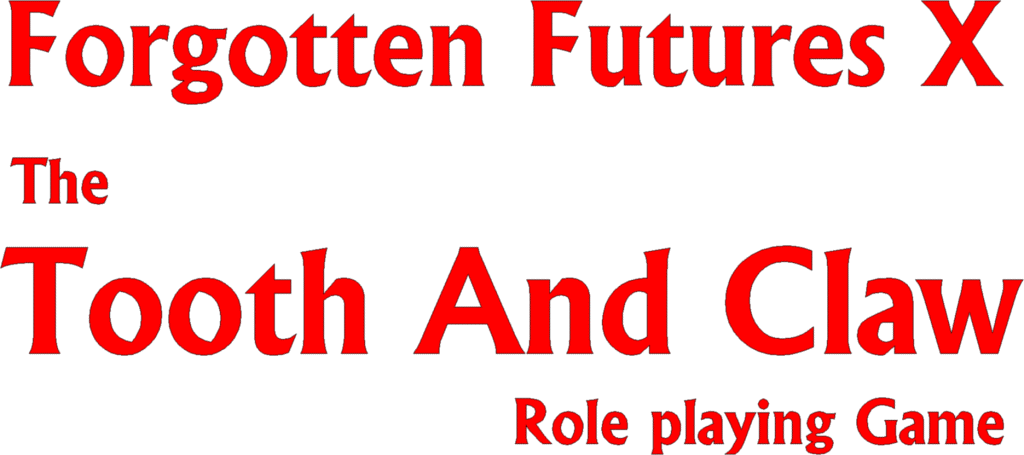

| Please Note: use of the PDF version of this file is recommended. While every effort has been made to keep the text and graphics contents of both files identical (apart from page numbering which is irrelevant to the HTML version), there are differences in layout and the PDF is prettier and MUCH easier to print! |
|
This is the multiple-file HTML version of this game, and its use is recommended if your computer has speed or memory limitations or a slow internet connection, or if you are using Apple's Safari browser under OS X. If these aren't problems for you, you might find the single file version more convenient. It is divided into four sections - an index file which contains copyright information and an index to all of the images used, this worldbook describing the game setting, the Forgotten Futures rules modified for dragon characters, and some adventures and other information for game referees. ~ Index ~ Rules ~ Adventures ~ The Death of Bon Agornin The Biology of Dragons Tiamath Out and About in Tiamath Society Religion The Yarge The Rules of the Game Adventures The Tenant of Copper Caverns The Crimson Claw Assurance Society Amazing Things Every Dragonet Should Know Epilogue: Past, Present, and Future End Notes ~ Index ~ Rules ~ Adventures ~ |
|
Don't believe everything you read... This is an authorised derivative work based on the novel Tooth and Claw by Jo Walton, and on its unfinished sequel Those Who Favor Fire. Its content has been approved by her, but nothing in it, other than direct quotes from the original texts, should be considered to be definite canon for this setting. Background details have been invented in areas where they were felt to be needed, and simplified to make the gaming aspects easier to handle. The only definitive sources for this world are the above works, and it's possible that any future works by Jo Walton that use this setting may contradict the game. |
| Contents |
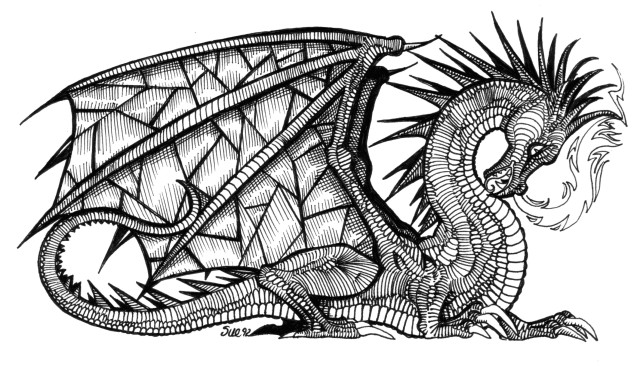
Bon Agornin writhed on his deathbed, his wings beating as if he would fly to his new life in his old body. The doctors had shaken their heads and left, even his daughters had stopped telling him he was about to get well. He put his head down on the scant gold in his great draughty undercave, struggling to keep still and draw breath. He had only this little time left, to affect everything that was to come after. Perhaps it would be an hour, perhaps less. He would be glad to leave the pains of the flesh, but he wished he had not so much to regret.
He groaned and shifted on the gold, and tried to feel as positive as possible about the events of his life. The Church taught that it was neither wings nor flame that gave one a fortunate rebirth, but rather innocence and calmness of spirit. He strove for that fortunate calm. It was hard to achieve.
"What is wrong, father?" asked his son Penn, approaching now that Bon was still and putting out a gentle claw to touch Bon's shoulder.
Penn Agornin, or rather the Blessed Penn Agornin, for young Penn was already a parson, imagined he understood what troubled his father. He had attended many deathbeds in his professional capacity, and was glad to be here to help ease his father into death and to spare him the presence of a stranger at such a time. The local parson, Blessed Frelt, was far from being his father's friend. They had been at quiet feud for years, of a kind Penn thought quite unbecoming to a parson.
"Calm yourself father," he said. "You have lived a good life. Indeed, it is hard to think of anyone who should have less to fret them on their deathbed." Penn admired his father greatly. "Beginning from very little more than a gentle name, you have grown to be seventy feet long, with wings and flame, a splendid establishment and the respect of all the district. Five of your children survive to this day. I am in the church therefore safe." He raised a wing, bound with the red cord that, to the pious, symbolised the parson's dedication to gods and dragonkind, and to others meant mere immunity. "Berend is well married and has children, her husband is powerful and an Illustrious Lord. Avan is making his way in Irieth. His is perhaps the most perilous course, but he has strong friends and has done well thus far, as you did before him. As for the other two, Haner and Selendra, though they are young and vulnerable do not fear. Berend will take in Haner and see her well married under her husband's protection, while I will do the same for Selendra."
Bon drew a careful breath, then exhaled with a little puff of flame and smoke. Penn skipped nimbly aside. "You must all stick to my agreement," Bon said. "The younger ones who are not settled must have my gold, what there is of it. You and Berend have begun your hoards already, let you each take only one symbolic piece of mine, and let the other three share what little is left. I have not amassed a great store, but it will be enough to help them."
"We had already agreed that, father," Penn said. "And of course they will likewise take the greater shares when we eat you. Berend and I are established, while our brother and sisters are still in need."
"You have always been just what brothers and sisters should be to each other," Bon said, and sighed more smoke. "I want to confess, Penn, before I die. Will you hear my confession?"
Penn drew back, folding his wings hard around him. "Father you know the teaching of the church. Not for three thousand years, six lifetimes of dragons, has confession been a sacrament. It reeks of the Time of Subjugation and the heathen ways of the Yarge."
Bon rolled his huge golden eyes. Sometimes his son, so careful of propriety, seemed a stranger to him. Penn could never have endured what he had endured, never have survived. "Six lifetimes you may have been taught, but when I was young there were priests who would still give absolution to those who wanted it. It is only in my lifetime and yours that it is forgiveness that has become a sin. What was wrong was paying for absolution, not forgiving the burdens of those who would lay them down. The rite of absolution is still in the book of prayers. Frelt would have refused me this, I know, out of spite, but I had thought you would have had spirit enough to do it."
"Yet it is a sin, father, and one the Church preaches against as strongly as priest-flight." Penn flexed his bound wing again. "It is not an article of religion, true, but a difference in practice that has arisen over time. Confession is now abhorrent. I cannot possibly give you absolution. If anyone discovered it, I would lose my position. Besides, my own conscience would not allow it."
Bon shifted again, and felt loose scales falling from him down to the gold below. He did not have long left, and he was afraid. "I am not asking you for absolution, if you cannot give it. I just think I will die more easily if I do not take this secret on with me." His voice sounded weak even to himself.
"You may tell me anything you wish, dear father," Penn said, drawing closer again. "But you may not call it confession, or say that you are doing it because I am a parson. That could endanger my calling if it became known."
|
Sue Mason |
Bon looked at the red cords on his son's wings, remembering what he had paid to have him accepted into the church and all the good fortune he had encountered there since. "Isn't it wonderful how so much came of your little friend Sher?" he said. Then he felt the pain spreading from his lungs, and wanted to cough, but did not dare. Penn had drawn breath to answer, but he subsided, letting it trickle out of his snout, watching his father's struggle in silence. Little Sher, once his schoolfellow, was the Exalted Sher Benandi now, lord of his own domain, and Penn was his parson, with his own house and wife and children.
"It is the way of the dragon to eat each other," Bon said at last.
"These days-" Penn began.
"You know I was the only survivor of my family, the only one of my brothers and sisters to grow wings," Bon went on, speaking over his son. "You thought that Eminent Telstie had eaten them, or perhaps his wife, Eminence Telstie? They did eat some of them, swooping down out of the sky to devour the weaklings, always leaving me alive, because I was the oldest and strongest. They held hard to the idea the church teaches that they were improving dragonkind by eating the weaklings, they were even kind to me. I did not forgive them for eating my father and my siblings. Yet I pretended to be a friend to them, and to their children, for my mother had little power to protect me or prevent them eating us all if they chose. They had taken my father's gold and we had nothing but our name. When there were but three of us left, I had grown wings, but was only seven feet long, ready to leave home to seek my fortune but in great peril if I did. I needed length and strength I could not gain from beef. I ate my remaining brother and sister myself."
Penn lay frozen beside his dying father, shocked far beyond anything he could have imagined the old dragon could have said.
"Will I die entire?" Bon asked. "Will my spirit fall like ash from smoke as the church teaches? Or will I be reborn as a muttonwool to catch in the teeth of someone's hunger, or worse, a creeping worm or a loathsome wingless Yarge?" His eyes caught his son's, and still Penn stared dumbstruck at his father. "I have lived a good life since, as you said. I have regretted it bitterly many times, but I was young and hungry and had nobody to help me and a great need to fly away."
Bon's scales were falling with a steady pattering. His breath was more smoke than air. His eyes were beginning to dim. Penn was a parson and had attended many deaths. He knew there were only minutes left. He spread his wings and began the last prayer, "Fly now with Veld, go free to rebirth with Camran at your side-" but the smoke caught in his throat and he could not go on. He had read the old rite of absolution once, in horrified fascination, his father was right that it was still printed in the prayerbook. It was absolution his father needed, and a clear spirit to go on. Penn was a conventional young dragon, and a parson, but he loved his father. "It is a custom, there is no theology behind it," he muttered. He held his claws up before his father's eyes, where he could see them. "I have heard your-" he hesitated an instant, it was the word that seemed so bad, could he call it something else? No, not to give his father the comfort and absolution he needed. "Your confession, Dignified Bon Agornin, and I absolve and forgive you in the name of Camran, in the name of Jurale, in the name of Veld."
He saw a smile deep in his father's fading eyes, which was replaced by peace, and then, last, as always, a profound surprise. However many times Penn saw this he never became accustomed to it. He often wondered what there was beyond the gate of death that, however prepared the dying dragon was, it should always astonish them. He waited the prescribed moment, repeating the last prayer three times, in case the eyes should begin to whirl again. As always, nothing happened, death was death. He delicately reached out a claw and ate both eyes, as was always the parson's part. Only then did he call his sibs, with the ritual cry "The good dragon Bon Agornin has begun his journey towards the light, let the family be gathered to feast!"
He felt no grief, no shame at having gone against the teachings of the Church to give his father absolution, no horror at what his father had done. He felt nothing whatsoever, he knew that he was in a state of shock and that once it wore off he would be quietly miserable for a long time.
Excerpt copyright © Jo Walton 2003 - the first chapter in its entirety is on line at www.zorinth.net/bluejo/
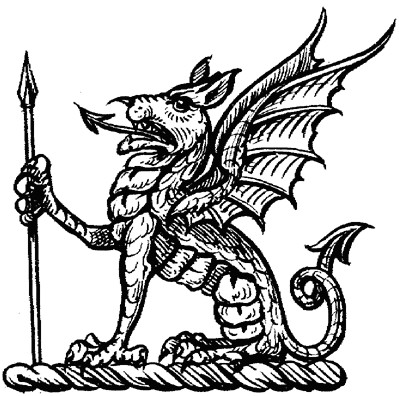 A veteran of the first Yarge wars displays a captured lance and instructs his sons in Yargish tactics. Meanwhile the enemy were inventing guns. |
| Contents |
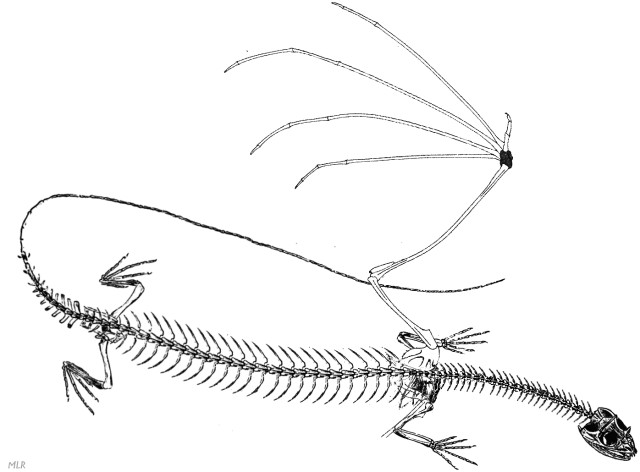
"I see you have thought it all out," Avan said, pulling himself to his feet. "My dear maidens, have you not considered that in addition to being seventy feet long and fire-breathing, father is, or rather was, nearly five hundred years old? I am barely one hundred, barely twenty feet long, and have no fire as yet, nor much prospect of gaining any soon. I am doing well enough in my career for one who began it when I did, but that was hardly ten years ago and I don't taste dragon meat twice in a year..."
Tooth and Claw - I:3
Dragons are warm-blooded oviparous vertebrates; at one time classical biology considered them to be unusual reptiles, but anatomical evidence suggest that their superficial similarities are outweighed by the differences, and that they should preferably be assigned to a separate vertebrate superclass, Draconi, containing the dragons and some primitive six-legged wingless relatives, somewhere between the reptiles and fish. This is still extremely controversial, with many naturalists preferring the old theories. They are intelligent omnivores with a preference for meat, especially that of their own kind. Most adult dragons are capable of flight, if not restrained by the bonds of servitude or faith.
Dragons can eat most fruit and vegetables, and a variety of meat animals including beeves and swine (and in former times Yarge, with princesses considered an especial delicacy). Carcasses are generally skinned but otherwise eaten whole and raw, efficiently dissected by razor-sharp fangs and claws; cooking passes through periods of popularity, but is currently unfashionable and condemned as a Yargish aberration by the church. The best dining rooms have efficient drainage gutters in the floor; after a meal the room can be sluiced clean of blood and other fluids in minutes. Beverages include beer and wines, fruit juices, and herbal teas.
Cannibalism is an everyday event, from the culling of inferior dragonets to the "retirement" of servants who become too old or infirm for work. Dragon meat is said to be magical; it ensures health and growth, and brings male dragons fire.
The first of these claims has been verified many times; dragons who dine on the flesh of their own species build muscle and flesh at a phenomenal rate, so rapidly that some experts believe that it bypasses the normal digestive process altogether. The mechanisms involved are unknown; eminent doctors have experimented with the vivisection of condemned prisoners, but learned little except that the speed and efficiency of absorption may gradually decrease with age and size - a young dragon in good health may convert 90% or more of the weight of meat eaten to flesh, almost as fast as it is eaten; an elderly dragon is lucky to achieve 50% efficiency and may take several hours to feel the full benefits of a meal.
It should be noted that dragons do not gain any of these benefits from eating any of the related Draconi species.
The efficiency of cannibalism allows dragons to use nutritional and reproductive strategies which the Yarge and other outsiders might find offensive, and even dragons find distasteful, unless concealed behind elaborate excuses and euphemisms; briefly, to rear their young as a food resource. Dragonets can be fed entirely on animal flesh and fruit, building up body mass which is available for consumption in an emergency. For this reason a female dragon might choose to feed all of her young, even those who would normally be culled, keeping the weaker specimens until she or one of her healthier dragonets needs an infusion of strength. Examples might include a mother who rears then eats a sickly hatchling to ensure that she will be healthy when she lays her next clutch of eggs, or a dragonet consuming his siblings. This use of living dragons as a food reserve is also seen elsewhere; condemned prisoners are kept alive and fed reasonably well until their flesh is needed. One use for their flesh is for the purpose of restitution in civil cases involving the disposition of inherited dragon meat; once eaten it can't be recovered, short of killing the offending party, so a substitute's flesh is provided by the court. Naturally the losing party pays dearly for this service, but when the alternative is to provide the meat from your own body the price isn't unreasonable.
The other claims for dragon flesh are probably just as valid; dragons eating dragon meat definitely seem to be healthier than those that do not, and the growth spurt following a hearty meal often triggers the first release of flame in males - but the connection here is much less certain, since flame can also be triggered by anger, injury, indigestion, or the sight of an unusually attractive female.
Flame is generated in the throat of mature male dragons; the fuel is a complex gas which ignites as it leaves the mouth. The source is believed to be liquid secreted by a pair of glands in the throat, somewhat like the venom glands in snakes, reacting with a second fluid secreted in the mouth. Liquid secreted by the throat glands is sucked into the upper lungs then exhaled rapidly as an aerosol of fine droplets; reflexes close a series of airtight valves behind it as it is exhaled. As it passes through the mouth the droplets come into contact with the second fluid and ignite. The precise mechanism of this process is unclear, since both of the components are highly volatile; all that is known with any certainty is that the supply of these liquids is finite and slow to replenish, and that its manufacture is a severe strain on the body. Dragons using it early and too often may be destined for an early death. They may also damage their teeth and tongue.
While flame is the most obvious distinction between male and female dragons, it is a late event in the life of most male dragons - as noted above, early flame, especially when used to excess, is generally a sign that a dragon's life will be unusually short - and there are two much more immediate differences between the sexes; the structure of the fore-limbs, and of the peculiarly delicate skin of females.
Hands: both sexes have five-fingered fore-limbs, but their hands are very different. Male dragons are specialised for strength and ripping power, with short broad fingers ending in claws several inches long. Females have longer but more delicate fingers and shorter claws. As a result males are rarely able to write or master other forms of delicate manipulation, and many of the arts and crafts are largely female preserves; for example, the Agornin residence is decorated with relief models of the surrounding area, constructed by one of the daughters of the house using a variety of tools and her claws. This distinction is not absolute - some male dragons, especially scholars, parsons, and artists, train with special tools such as pens with mushroom-shaped grips, and some females in manual employment develop arms as strong as many males - but these exceptions are rare.
Blushing: Perhaps the defining difference between males and females is the ability to blush. Males have thick dark skin with overlapping scales. Females have smaller gold-coloured scales embedded in more delicate tissues; the skin connecting the scales is suffused with small capillaries which swell and lend their colour to the skin when a maiden blushes. In the case of mild arousal (as when receiving a compliment or conversing with an attractive male) this process eventually subsides, but strong arousal causes blood to seep into the surrounding flesh; since the scales are not entirely opaque the colour-change tints the skin and reddens the scales themselves. This results in a deeper and permanent tint. Some folk remedies are said to reverse the infusion of blood, but there is allegedly a danger that a maiden thus treated will never be able to blush for her true love. These drugs are properly condemned by the church as encouraging promiscuity. Females are pink for the first few years after their first sexual arousal, darkening to golden-red eventually. It's generally assumed that any pink female is engaged or married, and that any red female is either married or widowed. Anything else is considered scandalous.

A female dragon's skin: before (left) and after blushing (middle), and after several years of marriage (right).
Close proximity to males can also trigger this change, so most well-equipped homes and all public areas include alcoves into which females can retreat to avoid male contact.
Unmated females eventually fade to grey, at which point they are permanently unable to reproduce.
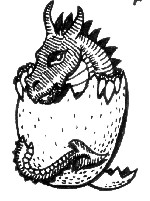 Eggs: Mated females can hope to produce several clutches of 3-5 eggs in a lifetime, provided that there is a gap of several years between broods. Females only lay if they spend some time eating a diet which promotes egg production, including special herbs, dragon liver, etc., and illegitimacy is virtually unknown. Over-frequent laying stresses the reproductive system and can cause the mother to become egg-bound, which generally results in an agonizing death.
Eggs: Mated females can hope to produce several clutches of 3-5 eggs in a lifetime, provided that there is a gap of several years between broods. Females only lay if they spend some time eating a diet which promotes egg production, including special herbs, dragon liver, etc., and illegitimacy is virtually unknown. Over-frequent laying stresses the reproductive system and can cause the mother to become egg-bound, which generally results in an agonizing death.
Homosexuality: Very much a taboo subject amongst dragons, homosexual behaviour exists but is never discussed publicly, and is most often seen in single-sex institutions such as the army, schools, etc. Females in homosexual relationships do not blush and eventually fade to grey.
Health: Dragons are generally remarkably healthy if they survive the first few years of life - childhood diseases and culling account for about 50% of dragonets in the first year, another 20% in the next five years. Naturally the death toll is highest amongst the poor, servants, and other lower orders, and reduced amongst the gentry. Once childhood is past a dragon in reasonable health can confidently expect to live three hundred years or more, often much longer.
Most forms of illness are signalled by abnormal coloration and defects of the scales.
Green scales are most often seen amongst hatchlings and dragonets, and are a sure indication that the child is fit only to be culled. The exact cause of this coloration isn't clear, but it is usually accompanied by failure to thrive and put on weight, premature wings, deformed claws, twisted tails, and other signs of abnormality. Greenness in later life is comparatively rare, and usually a sign of serious illness; if it doesn't clear within a matter of hours the victim is usually beyond all medical help.
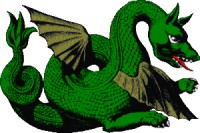
Scale loss is generally a sign of impending death. This condition - in which the scales simply drop en masse from the surrounding skin - is most often seen at the end of chronic illness or extreme old age. It must be distinguished from the localised scale loss sometimes caused by parasitic infections or rot; while disfiguring, this condition is rarely lethal if treated promptly. Causes include sand and grit caught under the scales, mites, fungal infestations, poorly-treated injuries, and dietary disorders. Over-frequent bathing is believed to be a contributing factor, but so is dirty skin. Treatments include hot poultices and washing with turpentine or ardent spirits. If scales are lost treatment with a paste made from crushed herbs and finely-powdered zinc oxide is sometimes effective. For extreme cases hot tar may stop the spread of infection and promote the growth of replacement scales; unfortunately the treatment is extremely painful, and can cause more problems than it cures.
Medicine: As indicated above, most dragon medicine tends to be palliative, generally treating injuries and the symptoms of illness rather than the underlying causes. Dragon doctors are aware of the germ theory - or rather, they have heard of it from the Yarge, who are more advanced in this field - but have yet to develop vaccination or antibiotics, or effective anaesthetics other than large quantities of spirits. There are numerous folk remedies and tonics available, varying considerably in efficacy; some are worse than useless, some surprisingly effective.
Drugs apart, medical procedures include stitching and cauterising wounds, amputations, resetting broken bones (although amputation is much more common), and midwifery; the latter is primarily emergency treatment of egg-bound females, and rarely successful.
Paediatric medicine is again limited to a few palliative treatments; seriously ill dragonets are almost invariably culled, and treating them is considered at best deceitful, at worst an affront to Veld.
Dentistry consists solely of extracting damaged or diseased teeth; dragons replace lost teeth very quickly, so there is no need for prosthetics, fillings, and the other remedies invented by the Yarge.
One roadblock to medical improvements has been the dragon inability to use microscopes; the peculiar structure of their eyes can't cope with the virtual images produced by their eyepieces (see sidebar for more details). Recently a new invention has become available; the 'microscope projector' is a cross between a microscope and a magic lantern projector, which shows the specimen projected onto a white wall or screen. Yarge usually find the results too dim to be useful for research, especially at high magnifications, but dragons have no problems adapting their sight to very low light intensity, and have begun to use the device; they now have some visual proof that microscopic organisms can live on and in dragons, but no effective means of dealing with them.
The College of Physicians in Irieth is the main authority for training and certifying doctors; there is no formal training structure for midwives, nurses, or apothecaries, although the latter must serve a long apprenticeship.
Hospitals exist, but only in the most wretched parts of Irieth and other large towns. They are generally seen as little more than abattoirs; places to die, with the doctors eating or selling the corpse if there are no relatives to defend it. The commercial market in dragon meat is in part driven by such institutions.1
Obviously an article of this length can't hope to cover every aspect of draconic biology; for more on these topics the reader is referred to A Dragonet's Guide to Nature by the Blessed Jamanah; The Biology of Dragons by Lh'ook of Migantil (a Draconic translation is available); and Curious Mysteries of the Dragon Heart by 'Dragon Q.'2
| Contents |
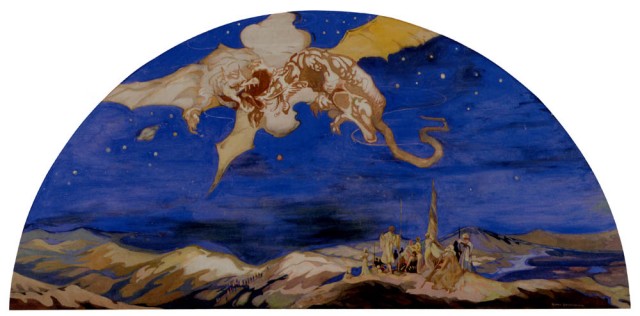
Two dragons fight for the honour of being the first to attack Yarge bandits on Tiamath's western border.
Hidden amongst the bandits, marksmen load their muskets and prepare to murder the victor.
Mural in the Yarge embassy, Irieth
No. I really don't think this one needs a map. - Jo Walton, Tooth and Claw FAQ
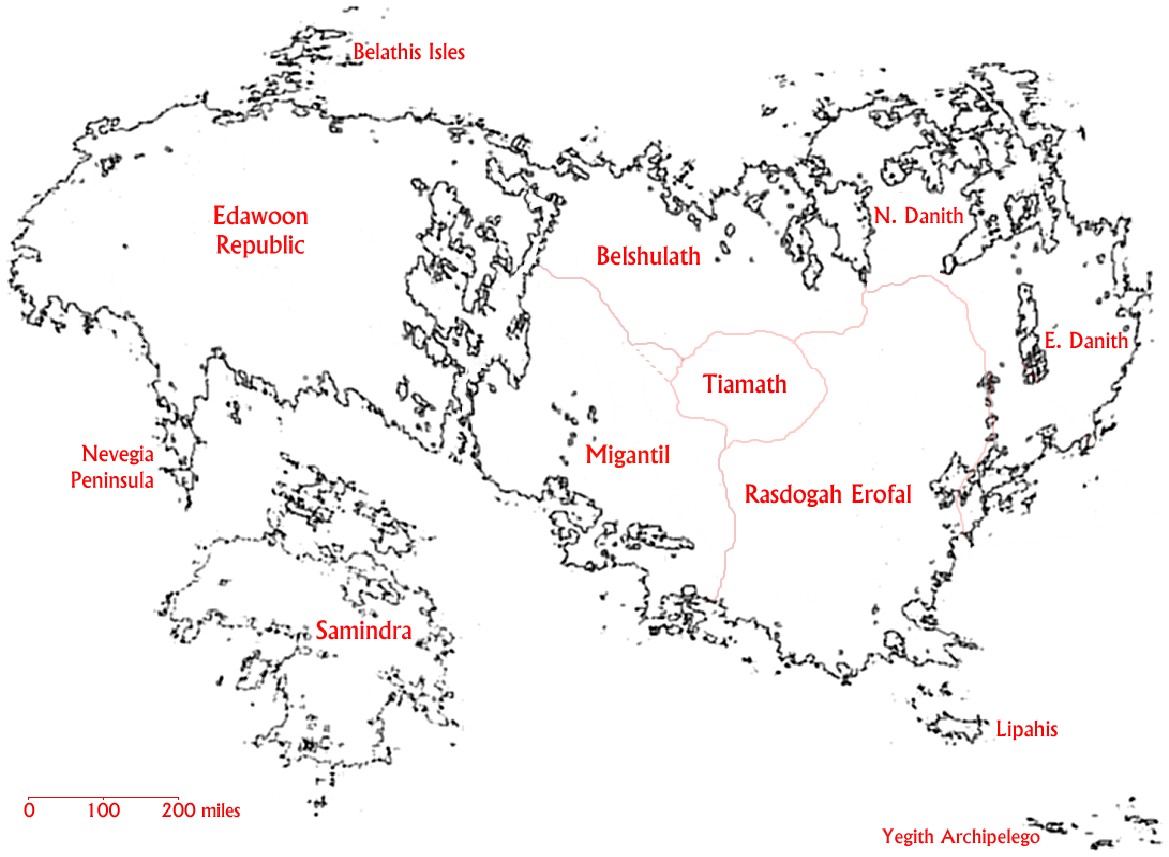 The setting for our tale is a world of diverse continents, climates, and societies whose history has largely been shaped by the existence of two competing intelligent species: Dragons and Yarge. Generally speaking the other animals and plants of the world are much like our own, though palaeontologists and zoologists would undoubtedly notice many differences; dragons didn't evolve in isolation, and there are related species surviving in out-of-the-way corners of the world. Some other geographical and astronomical details differ, of course; for example, the year is 200 days, but the days are somewhat longer.
The setting for our tale is a world of diverse continents, climates, and societies whose history has largely been shaped by the existence of two competing intelligent species: Dragons and Yarge. Generally speaking the other animals and plants of the world are much like our own, though palaeontologists and zoologists would undoubtedly notice many differences; dragons didn't evolve in isolation, and there are related species surviving in out-of-the-way corners of the world. Some other geographical and astronomical details differ, of course; for example, the year is 200 days, but the days are somewhat longer.
Tooth and Claw is set in Tiamath, the dragon nation. It's a temperate country, roughly oval, with a total area of approximately 16000 square miles, much of it mountainous, extending about 130 miles north-south and 200 miles east-west. Most of the mountains are in the south, and the whole region is buried in snow from autumn (the month of Leafturn) through to early spring (the month of Thaw). The largest city, Irieth, is in the north. Most of the countryside that is even marginally suitable is given over to agriculture, especially grazing, but there are also forests and hunting preserves, mining districts, industrial and commercial towns, a railway system, and everything else that might be expected in a prosperous but relatively small mountainous country.
History: The history of Tiamath is largely that of the Dragon-Yarge Wars, and frequently disputed, even by scholars nominally on the same side of the conflict. Very briefly, until about three thousand years ago there was no dragon nation as such; dragons were free to roam where they willed, and a match for anything except a massed body of Yarge troops. Because dragons are a quarrelsome species and benefit from cannibalism they tended to live in small groups, typically families whose younger males were driven off before they became a threat, dominating an area of a few hundred square miles per family. These large estates provided cattle and sheep, gold, Yarge princesses and other delicacies, and all of the other necessities and luxuries of draconic life. Occasionally a dragon would be killed by an unusually skilled Yarge warrior, or an unusually well-led war band, but this was very much the exception.
Unfortunately the Yarge discovered gunpowder and developed muskets and cannon, with catastrophic consequences for the dragons. Using their guns and superior military organization they fought a series of wars against the dragons, gradually exterminating the unwary and driving the rest into the mountainous region that later became Tiamath. The whole dragon race was in danger of extinction, until a now-forgotten leader suggested the unthinkable: surrender.
One of the conditions of surrender was the forced conversion of all dragons to the Yarge faith, later known to dragons as the Old Religion. Dragons that refused to convert were systematically wiped out. A prolonged occupation period followed, the Time of Subjugation, with dragons bound and forced to work for the Yarge overlords. During this period some of the great dragon hoards were looted by the Yarge, though others remained undiscovered.
Eventually the dragons mastered the secrets of gunpowder and rose up against their conquerors, driving them out of Tiamath, but many of the customs acquired from their conquerors were retained. The dragons remained isolated for many years, with occasional border wars continuing to the present day. Gradually trade developed, although relations between the two species will always be uneasy and many dragons who have lost relatives to the border skirmishes suffer extreme phobic reactions if they are ever unfortunate enough to meet a Yarge. Presumably some Yarge have similar reactions to dragons. Nevertheless, there is a Yarge embassy in Irieth, representing a coalition of the nations bordering Tiamath; occasionally Yarge tourists and merchants visit Tiamath, while many young dragons find a tour of Yargish lands such as Migantil to be an informative, if expensive, part of their education.
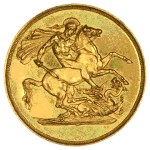 |
Yarge propaganda at its worst; this coin glorifies the murder of a dragonet, too young to fly, brutally slain by the sword in the years before the Yarge invented gunpowder. Incredibly, the Yarge didn't even eat their innocent victims! |
Some vestiges of Subjugation remain; the Yarge ambassador is armed as a matter of course, and still demands (and receives) the right to inspect all new dragons rising to the high rank of Eminent. The reason for this odd custom is a difference in the way that political and civil powers are perceived.
Most Yarge states have a hereditary "king", a leader whose rank approximates to the dragon rank of Majestic; the Yarge seem to believe that without such a ruler effective government is impossible. Dragons believe that power is not an automatic right; a Majestic will only be appointed if the circumstances are right, and if he genuinely has the abilities needed to take command. The machinery of government chugs along quite efficiently without a single guiding claw at the helm, and will undoubtedly continue to do so short of some unlikely destruction of Parliament and the civil service. If there is ever a real need for a Majestic, Parliament will appoint him.
Although there is no obvious need for a Majestic at present, the Yarge believe that if one is ever appointed it will be a sign of impending war. Previous Majestics arose from the ranks of the Eminent, hence their scrutiny. How they plan to recognize such a ruler before he takes power remains unknown; what they intend to do if they ever find one is also a mystery. They also seem to be confusing cause and effect; Majestics are appointed because war (or some other crisis) is immanent.
As a consequence of their defeat the dragons of Tiamath now live with a population density considerably higher than their ancestors, while retaining instincts that evolved for the needs of active omnivores with a preference for meat and a big hunting range. Under pre-conquest conditions Tiamath was the home of a few hundred dragons; today it houses hundreds of thousands. Unable to expand, and determined to avoid disruptions such as civil war, they have institutionalized violence and eugenic measures such as slavery, cannibalism and infanticide. Their nature makes these measures seem preferable to more peaceful solutions, such as birth control, but the price in terms of suffering and wasted lives is high.
|
Gold Dragons have a strong affinity for gold, both as a source of wealth and as a source of psychological comfort and beauty. There seems no obvious reason why a dragon should prefer a bed of gold to a bed of pebbles; they are similarly hard, and if anything the pebbles retain more heat overnight. But somehow the addition of a little gold makes a big difference, irrespective of the wealth of the dragon. A dragon with 10,000 crowns banked sleeps poorly compared to one with 100 crowns in his bed. Only the poorest of the poor and the most abused servants live completely without the precious metal; most dragons keep at least a few token coins in their homes, even if they never spend them. Most dragons prefer to sleep on at least a portion of their hoard, rather than keeping it in a bank earning interest; this doesn't indicate distrust of banks, which are splendidly reliable (penalties for bank fraud are extreme), it simply shows to the extent to which physical possession of gold is equated with security. Unless the hoard is unusually vulnerable (as in some city homes) much of its gold will never see the inside of a bank. Paradoxically, dragons consider gold to be less important than flesh. Most inheritance cases are about corpses, not money. Scenario Idea: There's Gold in Them There Holes... An old friend who works in the Public Records Office has found a map showing the location of three buried supply caches, left in Yarge territory 370 years earlier as part of the preparations for an invasion that never happened. While ancient rations and gunpowder are of little interest, he believes that the caches included chests of gold for paying the troops. The snag, of course, is that the caches belong to the state and are well beyond the frontier, and two of the three are near Yarge settlements. Getting at them without government interference or an international incident won't be easy. |
Economy: Despite its origin in defeat, Tiamath is a wealthy nation; many dragons hid huge hoards before the surrender, concealing them until the Yarge had gone. Even today forgotten hoards occasionally come to light, and the quality and value of some of these discoveries is startling.
This capital was augmented by mineral wealth and eventually by trade. Today the banks of Irieth take good care of their customers' money, and backed by immense wealth their services spread far beyond the city, and even beyond the borders of Tiamath. Even the Yarge need dragon banking facilities; while their own bankers can handle investments in the short term, a few years or decades, dragons can give personal attention to accounts whose maturation is measurable in centuries, and dragon banks and their officials must obey anti-fraud laws that tend to promote honesty on pain of execution. Several Yarge royal families have used these services, and their accounts have been known to out-last the dynasties that opened them. Yarge pamphlets decrying the banks of Irieth as "funding tyranny" occasionally circulate; it's widely believed that their source is a cartel of Yarge bankers.
Banking is the most obvious example of Tiamath's financial influence, but there are many others. The banks have interests in many foreign businesses, not least insurance, via Yarge proxies. Yarge insurers tend to take on long-term civic risks (such as bridges) on the assumption that they will probably never have to pay out in the lifetime of the company; should the need arise they frequently default on their promises. Dragons, on the other claw, know that nothing lasts forever, and that sooner or later there will probably be a claim. Their premiums are a little higher, but in the event of a genuine disaster they will always pay out, which is more than can be said for some Yarge companies. Needless to say all claims must be thoroughly investigated.
Although Tiamath is land-locked, dragon companies have extensive shipping interests, and favourable tax laws mean that dozens of Yarge ships are registered there and fly the Dragon flag of convenience. Shipping insurance is a growth industry, of course. There are a few dragon-operated merchant ships, based at ports around the Migantil coast, but most dragons have no great love for the sea, and it will never be a popular career. There is no navy; should Tiamath ever acquire a seaport it would probably be necessary to create one, but even the strongest proponents of draconic expansion don't envisage that happening any time within the next few hundred years.
While financial services are the largest single source of foreign revenue, the bulk of the country's income comes from more conventional trade; Tiamath exports wines and spirits, paper, perfume oils, lead, silver, antiquities1, steel, fertilizers, wool, hides, timber, and truffles. Imports include clocks and other fine mechanical devices, heavy engineering machinery (lathes etc.), tin, mercury, silk, cotton and mineral oil.
| Scenario Idea: The Dragons of War Several dragons, former soldiers fallen on hard times, are approached by a Yarge claiming to represent the Edawoon Republic. Edawoon is currently fighting an insurrection along the Nevegia Peninsula, but can't seem to wipe out the last guerrillas - or "Veldless monarchist scum" as he puts it - because Queen Tara of Samindra has given them asylum. The guerrillas are abusing her protection, using fast steam launches to raid targets along the coast of the Peninsula. For political reasons the Republic cannot make any overt move against Samindra, but if something unfortunate were to happen to the boats Edawoon would be very grateful. Of course things aren't quite as simple as is claimed - the boats actually belong to the Samindran navy, not the rebels, and the refugees are mostly innocent victims of the conflict, not guerrillas. Edawoon aims to close this escape route and use the remaining civilians as hostages to deter the insurrection. In the long term an invasion of Samindra may be explained as "defending" the country from Tiamath! Will the dragons uncover the truth, or become pawns in the war against Tara? |
The map shows Tiamath and its near neighbours - there are three other continents, of similar or larger size, but the sea passage is so difficult, and the flying distances so far beyond the range of any dragon, that they might as well be on other worlds. So far as is known no dragons live elsewhere; it is believed that the species simply never spread to those lands.
Migantil is Tiamath's main trading partner, with ports along the Narrow Sea (the channel and complex of saltwater lakes between Migantil and the Edawoon Republic, which averages ten to fifteen miles wide and is notorious for storm waves and tidal surges) and on the South coast. The government seems to be run by a cartel of guilds and powerful merchant families, with a nominal Prince who appears to be a pawn of whichever faction is currently controlling the cartel, but the details are so obscure that even natives often seem to be uncertain how it works.
Belshulath is a hereditary monarchy. It also trades with Tiamath, though to a lesser extent, and offers Tiamath its only navigable water route to the coast, via the River Toris. There is a long-standing disagreement between Belshulath and Migantil over a narrow triangle of about a hundred square miles along the frontier between these nations; currently Migantil occupies it, but Belshulath has a strong historical claim. This area is important because the rail link from Migantil to Tiamath runs along its length; if Belshulath ever takes it back trade to Migantil would be seriously hampered, to the benefit of Belshulath.
The last of the nations bordering Tiamath is Rasdogah Erofal, whose Sultan is said to rule by Veld's divine right, although the religion that supports this belief bears little resemblance to any draconic faith. The culture is feudal, with the bulk of the population serfs owned by the Sultan or his knights. Warriors of this land are required to prove themselves by some daring feat of violence. All too often this is banditry along the border with Tiamath. The current Sultan is the first in several centuries to claim the title of "Dragon Slayer," which was once the main criterion on which the Sultan was selected. Details of this feat, and evidence for it, have yet to be revealed.
Further afield, Danith is currently engaged in a low-key succession war; the North is still loyal to the King, the Eastern states believe that their Queen is the legitimate ruler. Currently this dispute seems to be fought mainly through refusal to pay taxes, but there are fears that it will eventually become violent. The Edawoon Republic is (as usual) sabre-rattling, this time against Belshulath - the main cause is the plan to construct a canal linking the Narrow Sea to the North coast, on border land claimed by Edawoon (see below). Edawoon is probably too short of funds to mount an effective military campaign, since it is fighting insurrections along the Nevegia Peninsula and in the Belathis Isles. It is rumoured that the Republic has been trying to recruit dragon mercenaries but has yet to offer sufficient payment. The Queen of Samindra has declared her country neutral in this conflict, but is prepared to offer asylum to refugees from both sides. Finally, the Prince of Lipahis has again announced that he intends to suppress the pirates of the Yegith Archipelago, having previously claimed victory on several occasions. Dragon missionaries have made many converts in the Archipelago and both churches view this announcement with some concern, believing it is simply an excuse for a war against the faith.
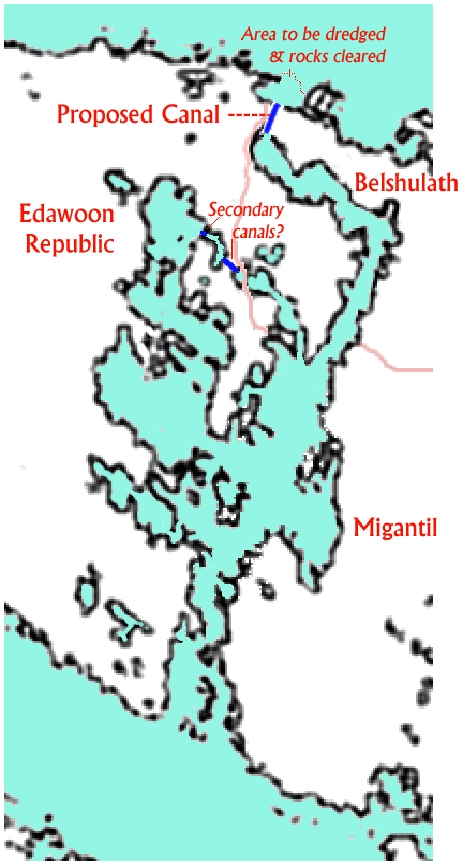 |
|
| Coastal trade is influenced by the major sea currents; in particular, there are adverse currents along the main coasts of the Edawoon Republic, and the maelstrom off the Belathis Isles, though rarely dangerous, adds delays. A canal linking the Narrow Sea to the North coast would bypass most of the Edawoonese coast and allow ships to circle most of the continent with the currents. Scenario Idea: Diplomacy! The adventurers, representing a major Irieth investor, must discreetly convey a large |
|
The Great North Coast Canal Company (GNCCC): Since most trade still goes by sea maritime affairs are obviously very important, and as already noted much of Tiamath's foreign income derives from trade and nautical insurance. The map shows an important factor in all maritime trade - the prevailing currents around the coast. Steamers use roughly a third less fuel by travelling with the currents, so the obvious coastal trading route is South out of the Narrow Sea, possibly visiting Samindra, along the coast towards Lipahis, whose coal reserves make the island an attractive port of call, north past Danith and back to the West towards the Belathis isles. Unfortunately things then get tricky; there is no way to complete the circle without travelling against the current for at least 600 miles.
The GNCCC is a consortium of Tiamath's banks, Migantine engineering companies, and private investors in Belshulath and the Edawoon Republic. The main project proposed is an 18-mile shipping canal linking the Northern seas to the Narrow Sea, providing a safe and relatively calm route to the South coast. Secondary works would include clearing and dredging the bay to the North, and possibly constructing two shorter canals to link the northern arms of the Narrow Sea. The main problem in all this is the opposition of the Edawoon Republic. The most practical route for the main canal is two to three miles east of their border with Belshulath, an area whose ownership has been disputed for many generations. Due to the structure of the rock, diverting the canal less than a mile to either side would double the cost, already estimated at fifty million crowns. Most of the profits will come from fees charged to use the main canal, benefiting the investors and the Belshulathi government, but not Edawoon. The secondary canals would be on Edawoonese soil but would earn much less; they are mostly in the plan as a sop to the Edawoonese government.
Edawoon complains that the canal would harm its coastal areas, but the reality is that the western parts of the country are sparsely populated, and the Republic has several excellent natural harbours along the Narrow Sea, and rail links to most parts of the country. If some agreement could be reached Edawoon's economy would benefit from the change. Meanwhile the sabre-rattling is deterring investment.
|
The Railways Although it is a comparatively recent innovation, only a few hundred years old, Tiamath's broad-gauge railway system is slowly stretching into all districts except the most mountainous. Apart from the gauge, which is a foot wider than Yarge tracks, the most obvious difference between Yarge and dragon trains is the design of railway carriages; while goods wagons seem to be much the same everywhere, passenger wagons on a dragon train are low-sided and open to the elements, not enclosed boxes. Dragons prefer to travel with the wind in their faces, using their claws to stay aboard and on top of their hoards even if they sleep, but able to take flight if they wish to exercise during a journey. The top speed is about 25 MPH so they can easily keep up. Yarge passengers must travel in goods wagons or make special arrangements before using the railway; a few closed carriages are kept for this purpose. Engine drivers and train crew are free employees, not bound servants. While the broad gauge is more comfortable and stable than that used by the Yarge, it means that goods and passengers must normally transfer from one train to another when they enter or leave Tiamath. The only exception is a Yarge-owned narrow-gauge line from Migantil into the capital, Irieth. Scenario Idea: Night Mail A group of dragons happen to be travelling aboard the Night Mail from the Mines of Tolga to Irieth one foggy evening in late Leafturn. It's a boring journey; with the tracks shrouded in mist nobody feels like flying off for a little exercise, and it's too early and damp for easy sleep. Looking for alternative forms of amusement, someone suggests telling stories... Get the players to tell stories based on the backgrounds and interests of their characters - tales of the Yarge wars, romance, buried hoards, ghosts and quirks of fate. Nothing important depends on the outcome; it's just a way to add depth to their characterization. Industry & Technology Currency |
Foreign Policy: While the Yarge sometimes seem to have trouble understanding dragons, there can be no doubt that dragons are usually uncertain when they deal with the Yarge world. For the most part current foreign policy is to avoid getting caught up in another war until the time is right - when there are real territorial gains to be made. For example, the border dispute between Migantil and Belshulath might at first glance look promising, but it has smouldered for at least two hundred years without ever getting much beyond angry words. If things ever got more heated there might be a temptation for Tiamath to intervene and seize the territory, but it would disrupt trade, and might even unify the Yarge nations against Tiamath! Currently none of Tiamath's neighbours seems particularly vulnerable to invasion, so the government mostly looks to trade (especially the financial industry) as a way of gaining power and influence in the outside world, and discreetly encourages that part of the economy. There are occasional rumours of secret attempts to colonise unoccupied areas outside Tiamath, but if anything like this is occurring it is being kept very quiet indeed. Certainly there seem to be no colonies anywhere on the local continent. But as already noted there are other continents...
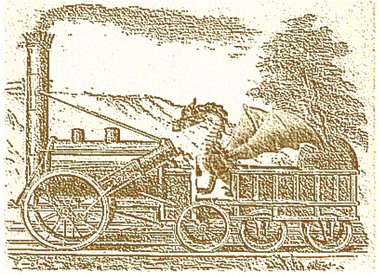 Communications: Yarge visitors to Tiamath are often surprised to find that there is a well-maintained transportation and communications network; they seem to think it odd that dragons often prefer to travel by road or rail, or send messages rather than flying with them. But goods can't move themselves and dragons often travel with unusually heavy luggage: their hoards. Add to this the fact that many younger dragons cannot fly, and that most servants and the clergy are prevented from doing so, and it becomes apparent that dragons need facilities at least as good as those available to the Yarge.
Communications: Yarge visitors to Tiamath are often surprised to find that there is a well-maintained transportation and communications network; they seem to think it odd that dragons often prefer to travel by road or rail, or send messages rather than flying with them. But goods can't move themselves and dragons often travel with unusually heavy luggage: their hoards. Add to this the fact that many younger dragons cannot fly, and that most servants and the clergy are prevented from doing so, and it becomes apparent that dragons need facilities at least as good as those available to the Yarge.
Roads are well-built and kept in good repair, and bridges are strong and durable even by dragon standards. There are no riding beasts suitable for dragons, but wagons pulled by drafters (oxen) are used for transporting goods and occasionally passengers. It takes eight to pull a wagon loaded with three medium-sized dragons and their luggage, including a modest hoard. The Yarge are known to have experimented with land steamer carriages which run on roads rather than rails, but the technology is in its infancy and hasn't reached Tiamath.
Most rivers in Irieth are too narrow and fast-flowing to be navigable; the exception is the River Toris, flowing North out of Irieth towards Belshulath and the sea, which is navigable by barge and steam launch, and one of the main routes for cargo in and out of Tiamath.
The postal service is efficient and reasonably priced. Fees are based on the distance and route used; mail is normally delivered to the nearest post office, not to individual homes. In towns such as Irieth and Tolga there are post offices in every district; in country areas the post office is normally the local railway station. Servants are sent to the station with mail, and collect any that has been delivered. For a premium above the usual fee the postal clerk delivers urgent mail, rather than waiting for it to be collected. Urban post offices employ a few fit young dragons as messengers for this purpose. In the worst case (mail from the Eastern frontier to the far West and vice versa) it might take two days for mail to reach its destination, but for most destinations a day is the norm.
Flying messengers are occasionally used to carry mail door to door, especially in towns, but on most long-distance routes the normal post is almost as fast, when allowance is made for headwinds etc., and a good deal cheaper. Finally, it should be mentioned that military signals are sometimes sent via reflected sunlight, using the 'heliograph' device, and that recent developments in the study of the electrical fluid suggest that it may eventually be possible to send messages almost instantaneously by wire, over distances of several miles.
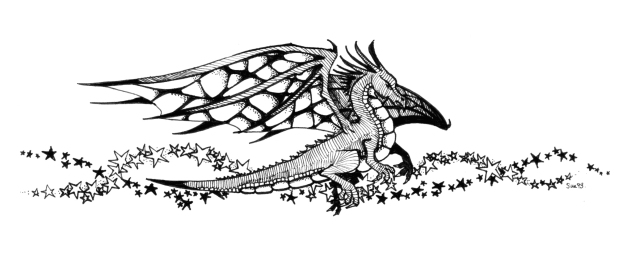
Sending messages via the electric fluid - an artist's impression
The Irieth Journal, Highsummer '07
Money and Prices: Wealth is of course an immensely important matter to any dragon who hopes to rise even slightly above the common herd. While gold has huge psychological importance, as discussed above, its more mundane significance should not be overlooked. Without an ample supply of gold it's impossible to live in any style, and good marriages become inconceivable; while romantics talk of marrying for love, realists quote the ancient draconic proverb
| Beeve carcass | 5 cr. | Hat, dragon | 1-3 cr. |
| Swine carcass | 2 cr. | Hat, dragoness | 2-5 cr. |
| Muttonwool carcass | 1½ cr. | Magazine / journal | 1/8-¾ cr. |
| Lepus (rabbit) carcass | ½ cr. | Book, leather binding | 2 cr. |
| Fowl (chicken) carcass | ¼ cr. | Newspaper | 25-75 pc. |
| Beer, quart | 5 pc. | Theatre performance | 1-2 cr. |
| Beer, gallon | 15 pc. | Music hall / vaudeville | ½-¾ cr. |
| Beer, 48-gallon cask | ½ cr. | Rifle for dragon | 20 cr. |
| Spirits, Pint | 50 pc. | Pistol for dragon | 10 cr. |
| Good restaurant meal | 2 cr. | Shotgun for dragon | 15 cr. |
| Cheap meal | 1 cr. | Percussion caps, 50 | ¾ cr. |
| Train fare (10 miles) | 1 cr. | Powder cartridges ** | 3 cr. |
| Cart hire, mile | 5 pc. | Rifle bullets, 50 | 4½ cr. |
| Drafter hire, mile | 10 pc. | Pistol balls, 100 | 3 cr. |
| Steamship, 100 miles | 15 cr. | Birdshot, 50 bags | 4 cr. |
| Cargo, 100 miles, ton | 5 cr. | Watch (Yarge made) | 10 cr. |
| Letter, per oz. * | 1/8 cr. | Daily wage, clerk | ½ cr. |
| Parcel, per lb. * | ½ cr. | Civil servant, per day | 1 cr. |
| Courier, per mile | 50 pc. | Lawyer, per hour | 10-30 cr. |
| * Most routes in Tiamath; double all prices for especially long routes or international postage. |
** Gunpowder in paper tube; 50 for pistol or 30 for rifle or shotgun. |
||
"Never marry for money but marry where money is."
In other words, love might be desirable, but it doesn't pay the bills - and for a dragon who wishes to move in Tiamath's society the bills can be very high indeed. On a more mundane level, even commoners have to eat, and despite their lack of wealth seem to find money just as worrisome as the nobility. Fortunately the nobility have an advantage; they can generally pay someone else to administer their funds, and need only worry about the total income and outlay.
It would be tedious to devote too much space to prices since most readers can be assumed to be dragons of means, who will never have to worry about them anyway. Total wealth can be important; for example, 8,000 crowns is not an enormous fortune or a particularly good dowry, but it will pay basic expenses for a few years. Meat and other agricultural products are relatively cheap, while luxurious trinkets requiring fine workmanship (such as watches and other small mechanical devices) must generally be Yarge made and often imported. The prices shown are typical, but add 25% - 50% (sometimes more) to all prices in Irieth.
| Contents |
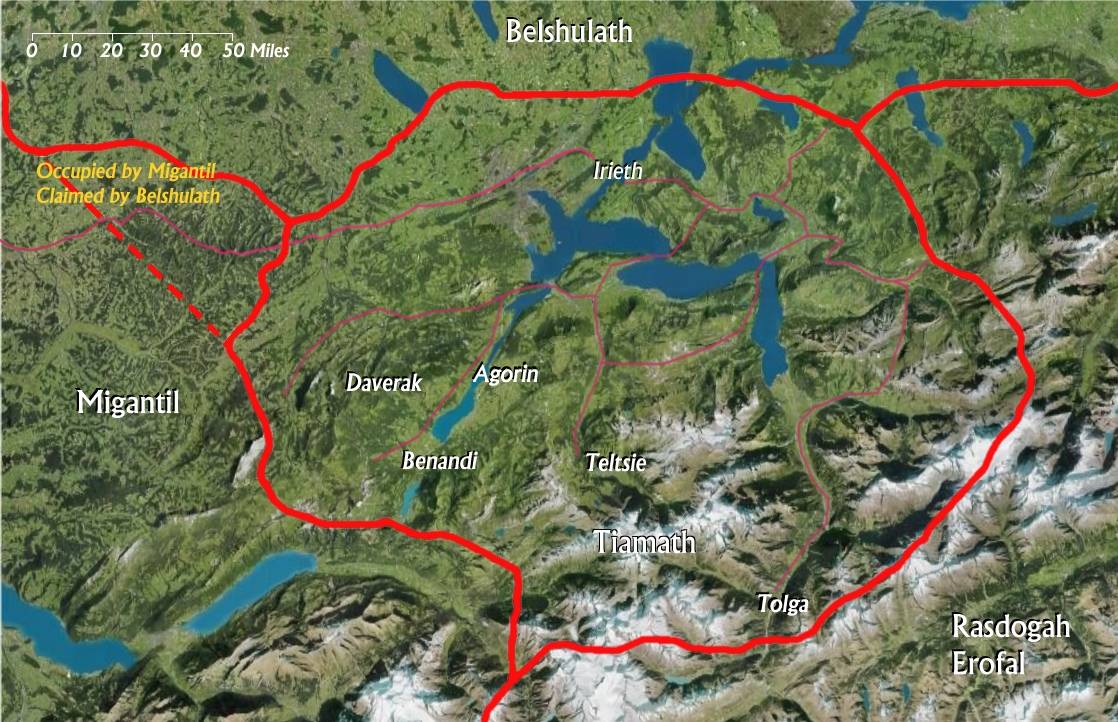
The geography and main railway routes of Tiamath; secondary and local lines omitted.
The sun was setting in a blaze of cloud away west down the valley, turning the curves and meanders of the river to flame, still bright enough for them to need to shield their eyes with their outer lids. It was the last day of the month of Highsummer. The crops were well grown in the square fields, spread out like a green and gold patchwork beneath them, outlined by the ragged hedgerows. Here and there they could see low buildings, tiled in mellow red, byres for the beeves and sties for the swine. They could see no abode of dragon, for the farmers of Agornin lived, by long custom, in their own section of the Dignified's establishment...
Tooth and Claw- II:5
Tooth and Claw is set in various country districts of Tiamath and the capital city, Irieth. A few other areas are mentioned, without many details.
The country is split into the holdings of the aristocratic families, with a leavening of wealthy (but somewhat less respected) new land owners such as Bon Agornin, whose fortune was originally acquired in trade three hundred years earlier; he bought his lands and the title that went with them, then married an impoverished but well-born bride so that his children would have aristocratic blood. It isn't a coincidence that the railway and station are so close to the Agornin residence; Bon Agornin sold the railway company the right of way across a corner of his estate, one of the conditions being that there should be a station on his land. This benefited the railway, which would have otherwise had to divert several miles through harsher terrain, and the consequent ease of shipping farm goods to Irieth is one of the reasons for the prosperity of the estate. Another profitable sideline is made possible by the railway: drafters are put out to graze alongside the track, and can eventually be sold in the city with a guarantee that they are hardened to noise and will not easily be startled.
In other respects Agornin is a typical country estate, perhaps equivalent to a Yarge village. It consists of a cave complex housing the family, with their servants and some farmers and their families in connected caves. They administer the farmland for a few miles around. The district is hilly rather than mountainous, and most of the caves have been dug out by generations of occupants, not natural forces. The area controlled by a family is determined by the status, wealth, and fighting ability of the male head of the family; when Bon Agornin died no other member of his family was capable of defending his holding, and the remainder of the family were forced to split up and live elsewhere or move to the city. It became part of the nearby Daverak estate, which was somewhat larger but less conveniently located.
Benandi is larger than either of these estates, stretching for several hours' flight in all directions, and has a much more imposing residence, Benandi Place, built on several levels, a "complicated honeycomb of caves at the top of a cliff." There is a parsonage at the base of the cliffs, with a tunnel leading up to the rest of the complex, and a "splendid chapel" large enough for all the occupants inside the main residence. The caves are natural, not excavated, another sign of the family's wealth and power. Until recently the estate was run by the matriarch Exalt Benandi, the widow of Exalted Marshal Benandi and driving force behind the family's prosperity. Her son, Exalted Sher Benandi, took control of the estate after his marriage, having had to force her to yield her authority on pain of being eaten. The family also owns a large town house in Irieth and other properties around Tiamath.
Much of the prosperity of Tiamath derives directly or indirectly from mines in the Tolgar district and the Tolga estate, from factories in the same area, and from other areas like them, but most upper-class dragons prefer not to dwell upon sordid matters of trade. Instead they focus most of their attention on the other end of the railway, the city of Irieth.
Flying in Irieth could never be the joy it was in the country. Many dragons refused to fly at all in the capital, saying it was dangerous as well as unpleasant, because of the unpredictable winds caused by the buildings and the heat of so many dragons living together. They walked the streets, or hired drafters and carriages... ...From up here, the city looked beautiful. He could see the patterns made of the tiles on the rooftops, and the accidental patterns made by so many rooftops together. He swept by the six towers of the Cupola, taking care not to fly directly above them, and glimpsed children playing down in the courtyard. The houses were silent, but the streets were full of early commerce - here a market selling fruit, fresh from the country, there beeves and swine being driven from the railway to their final market. The silver shining lines of the railway led from the grand arches of the Cupola station across the city...
Tooth and Claw - VI:22
| Waste Management Like any other big city Irieth needs an elaborate infrastructure to provide the basics of civilised life: running water and sewage, rubbish disposal, fuel, etc. One advantage that Irieth has over Yarge cities is a reduced need for water and sanitation; while dragons bathe and drink, they do so much less often than Yarge, and their droppings are mostly composed of solids, a mixture of indigestible food remnants and digestive residues, much like those of snakes. They can be shovelled away fairly easily, and doing so is one of the duties every servant has to do at one time or another. In the country they are usually dug into fields and gardens as fertilizer; in the city the sheer quantity of material involved can cause problems. Dumping everything in the river might seem an easy answer, but it has been tried several times in the past; not only does it pollute the drinking water supply, but sooner or later the river turns green or red with an overgrowth of algae and the fish die. Fortunately this problem suggests an obvious use for the material; it can be processed to make fertilizers, rich in nitrates and bone meal, and other chemical products. A by-law requires all homes in Irieth to have an appropriate waste receptacle, accessible from outside, which can be emptied easily. By night wagons belonging to the district waste companies prowl the streets, their crews emptying the receptacles (and also collecting other wastes such as skins, bones, etc. that have not been consumed), and eventually delivering them to a processing facility down-stream of the Skamble. There the material is sorted and most is dried, ground, and packed for shipment. About 35% is sold in Tiamath; the rest is barged downstream to Belshulath where it is an important resource for the chemical industry. Migantil companies have also expressed interest, but the cost of shipping by rail is considerably higher, and it is currently cheaper for them to buy the final products from Belshulath. Urban Housing |
Irieth is the capital and oldest city of Tiamath. Straddling the river Toris, legend claims that it was founded by Tomalin the Great, the Majestic who led the revolt that eventually drove the Yarge out of Tiamath. Some features of the layout suggest that this is not entirely true - the remnants of the original city walls, surrounding the City (the financial district) and the Circle (the university) have a look of Yarge defensive construction. They are now largely demolished, apart from the deep foundations, the stone long since salvaged for building projects and pierced by numerous roads and a railway line. A plausible theory is that the City was originally the main Yarge garrison during the Time of Subjugation, with dragons living around it until the rebellion began. It's telling that despite these fortifications the City has apparently never been used as a seat of government by dragon-kind.
The real centre of government is, of course, the Cupola, or rather the elaborate system of artificial caves underneath its defensive towers, where Parliament meets; see below for more on the composition of the government. If for any reason Parliament sees fit to appoint a Majestic, a ruler analogous to a Yarge "King," his offices and apartment will also be below the Cupola. It is a criminal offence to fly over the Cupola while Parliament is in session, for fear that a vote will be interrupted or there will be some other disruption of the business of government. Sessions often continue through the night, or run continuously for several days, and there is no way to determine the status of things from above, so most prudent dragons make a point of flying wide at all times.
The Courts of Justice (discussed below) are also underground, in Irieth's only notable natural cave system.
As should be obvious, all of Tiamath's railways lead to Irieth. As already noted all are broad gauge, with the exception of the Migantil line which terminates at the Migantine station. The design of this station is unusual, in that the narrow Migantil lines come in at one end, standard Tiamath lines at the other. Passengers need simply cross platforms to transfer from one system to the other.
The Migantine district has Tiamath's highest concentration of Yarge, as visitors and permanent residents. Despite this there is comparatively little trouble in the area and it is a popular destination for tourists and visitors seeking a frisson of foreignness without the expense of taking the Grand Tour. Many of the buildings copy Migantil architectural forms, with high vaulted ceilings. The area has a (largely undeserved) reputation for racy living, and many of the city's artists live there and practice the traditional skills of sculpting, painting, and sponging off rich relatives.
The main station and portal to the rest of Irieth is opposite the Cupola. The terminus combines passenger and freight facilities, with food and livestock mostly coming in early in the morning, passengers in the afternoon and evening.
Some other districts shown include the wealthy South-West Quarter, where many peers have their town houses, and the Marshalling Quarter, centred on the main army barracks for the city. At one time the surrounding streets were crowded with inns and less reputable facilities catering to the needs of soldiers, but these have gradually been replaced by wealthy residences. Soldiers in search of amusement must now cross the river to the Migantine Quarter, or look further afield.
Finally, perhaps the most wretched quarter of Irieth is the Skamble, a district of slums, warehouses, and breweries on the North bank of the river opposite the Cupola. The Planning Department recently unveiled proposals to redevelop the area, re-house many of the occupants, and demolish the worst of the slums. New facilities will include properly excavated homes, a new school, etc. The residents have cautiously welcomed the proposal, but critics note that it will do little to remedy the underlying problems of the area or provide new employment, and recent inflammatory pamphlets suggest that (despite the endorsement of several Old Religion priests) it is nothing more than a crude attempt to destroy Irieth's largest Old Religion community.
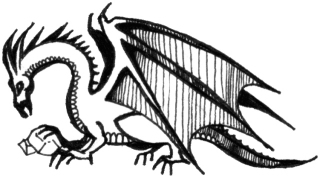
| Contents |
|
The Peerage Dragon titles are similar in purpose to those used by many Yarge cultures, approximate equivalents being:
With the following exceptions these titles are hereditary or can be acquired by marriage: Home Life Fashion Society Events Skin and Bones |
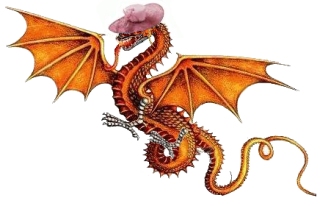 |
A fashionable young maiden risks the air currents and updrafts over Irieth, her skin burnished to perfection, her face largely concealed by a stylish but somewhat impractical example of the milliner's art. |
Some gently-born dragons who cling tightly to the rank in which they were born, or have achieved by marriage or accomplishment, do not favour those whom life has placed in rank above them. The Exalt did not suffer from this fault. There were not many who ranked above her own Exalted status, but those there were, Eminent and Eminences, Augusts and Augustas, she courted assiduously. She often regretted the loss of the Majestics and Highnesses and Honourables of old, there was nothing she would have liked so much as the thrill of having a Highness deign to drop in on a party she had arranged. Deprived of this, she made the most of August Fidrak, who endured her fussing graciously.
Tooth and Claw - XV:56
Tiamath is governed by an oligarchy of peers combined with an intermittently-appointed non-hereditary monarchy and an extensive civil service. This makes good sense to the peerage, although the commoners who are affected by their decisions undoubtedly have other ideas. Parliament, also known as the Noble Assembly, is simply a representative selection of male peers, each nominated by at least a hundred free dragons; nomination is largely the result of patronage and lobbying for seats as they fall vacant, and it is rare for new seats to be created. A Member of the Assembly theoretically gains no special privileges or income, over and above those normal to his rank, but of course the position is extremely influential - most Members find ways to benefit financially and extend their own patronage to their friends and families. Parliament meets in a complex of caves under the Cupola in the capital, Irieth. Originally the Assembly only met as necessary, but for several centuries the necessity seems to have arisen nearly every year, and there is now a fixed Parliamentary term, the Season.
In the event of a crisis requiring rapid decision-making, such as war, Parliament may appoint a Majestic - essentially a King - from the ranks of the Eminent, and if the situation demands it one or more Honourables, designated heirs or understudies positioned to take the Majestic's place in the event of his death.
The Yarge appear to believe that this happens suddenly; in fact it may take years for the Assembly to decide that a Majestic is needed. Several hundred years later Yarge who have no personal knowledge of events may think that it was a sudden change, of course. While the Majestic has many privileges, not least the power to appoint members of the peerage, the appointment is always fraught with difficulty, and most die (through stress-related illness or assassination, or on the field of battle) within a century of accession. If there is still need for a Majestic an Honourable will be appointed to take his place, or if this is not possible another Majestic will be chosen from the Eminent.
Below the Peerage are the commoners, free dragons without title; these include tenants of the peers (such as farmers), tradesmen, merchants, members of the Civil Service, and the general mass of the population, existing in various degrees of wealth or poverty according to their fortunes under Veld. It is possible for such dragons to rise to the peerage through marriage or by buying a title, as in the case of Bon Agornin, but rare. Commoners can serve on juries, have nominal rights under law, and may even be rich or have other forms of power, but they may not hold political office.
The "criminal classes" are those dragons with no formally acknowledged existence in the world; they do not pay taxes, cannot legally purchase property such as homes, and cannot serve on juries. The term for this class reflects the fact that it contains most of Tiamath's criminals. It's also the main source for indentured servants and "other ranks" soldiers.
The final class is that of indentured servants, essentially serfs or slaves sold into service by their families. Depending on their employer their lot varies from tolerable at best to wretched at worst, and their rights are virtually non-existent. Usually their wings are bound to prevent flight, except in the case of some especially trusted servants. A good master may eventually permit an old servant to retire, but this is far from the norm; most work until they drop, and a pitiful minority are eaten as soon as they weaken. Servants rarely grow beyond six or seven feet, and in most cases they never taste dragon flesh, or keep more than a token gold piece or two for their beds.
Recent years have seen the beginnings of a political movement for the betterment of servants, spearheaded by the writings of the Blessed Calien Afelan; whose book The Subjugation of Servants has attracted some attention amongst the better classes. There is little impetus for change, but he and his supporters are working to ameliorate some of the worst abuses and build up support for reform. This movement is, of course, linked to the growing freedom allowed to the Old Religion.
"I know that the Judges won't order me eaten, but they have the power to do so. The law stands to allow dragons like me redress against dragons who are stronger, but the Judges can order anyone to fight anyone at any time."
Tooth and Claw - XII: 47
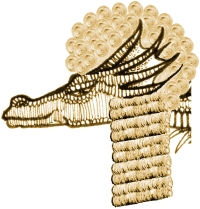 Tiamath's legal system consists of an appointed judiciary with jurors selected from the available commoners (and if necessary peers) in the area where the trial is held. In rural areas this often means that it is virtually impossible to select an impartial jury in cases involving the local peer; most of the jurors will be his tenants, employees, etc. The Peers tend to regard this as a good thing, and try to arrange things accordingly, others aren't so sure. In general city courts are considered to be less biased, and anyone bringing an action against a high-ranking opponent does his best to ensure that it will go to the Courts of Justice in Irieth, where it might be treated a little more fairly. But Judges are also usually Peers, so there may still be a bias - and the Judges can choose to bypass the jury if they feel that the facts in a case have been proved beyond all reasonable doubt. For criminal cases a single Judge is usually sufficient, three Judges may preside over complex civil cases. For reasons long forgotten all court officials, including attorneys, wear woollen wigs in imitation of Yarge, the size and style reflecting their role and importance to the court. Judges (addressed as "Honourable" in court) wear tall 'justicewigs' with high piles of rolled wool.
Tiamath's legal system consists of an appointed judiciary with jurors selected from the available commoners (and if necessary peers) in the area where the trial is held. In rural areas this often means that it is virtually impossible to select an impartial jury in cases involving the local peer; most of the jurors will be his tenants, employees, etc. The Peers tend to regard this as a good thing, and try to arrange things accordingly, others aren't so sure. In general city courts are considered to be less biased, and anyone bringing an action against a high-ranking opponent does his best to ensure that it will go to the Courts of Justice in Irieth, where it might be treated a little more fairly. But Judges are also usually Peers, so there may still be a bias - and the Judges can choose to bypass the jury if they feel that the facts in a case have been proved beyond all reasonable doubt. For criminal cases a single Judge is usually sufficient, three Judges may preside over complex civil cases. For reasons long forgotten all court officials, including attorneys, wear woollen wigs in imitation of Yarge, the size and style reflecting their role and importance to the court. Judges (addressed as "Honourable" in court) wear tall 'justicewigs' with high piles of rolled wool.
Apart from Judges and the other court officials there are three main types of lawyer in any trial:
Some lawyers take on two or all three of these roles, changing their wigs as often as may be necessary to perform each function. While this would seem to be a disadvantage, if the other side in the case has all three types of lawyer, a one-dragon presentation can give the impression that the client is a victim in the case. It also gives the lawyer the opportunity for a good deal of "business" with the wigs, changing quickly to give an air of efficiency, slowly for pathos or to raise tension, etc.
The powers of the court are literally draconian. In civil cases the parties may be ordered to fight to the death to settle the dispute, or pay damages in money or flesh - their own or that of a condemned prisoner purchased in lieu. In criminal cases penalties include fines or involuntary servitude (enforced by chaining the wings rather than tying them normally), but the most common sentence is death. Condemned prisoners are fed well until their execution, to ensure that they make a good meal. Unwary Yarge who have been unfortunate enough to get caught up in the system, but lucky enough to be freed, often marvel at how well dragons treat their prisoners. Usually they find the explanation disturbing.
In some unusual criminal cases the court may sentence prisoners to execution without consumption; their bodies will be burned, not eaten, since their crimes are considered so heinous that they would contaminate anyone who consumed their flesh. It's the traditional punishment for unjustified assassination of a Majestic, treason, etc. This is considered more horrible than simple execution; it punishes the family of the criminal, as well as the criminal himself, unless the court makes some provision for them. Many dragons believe that they will only reincarnate as dragons if their bodies are eaten by other dragons; it's not actually religious doctrine, but for those who believe it there is nothing worse than this form of execution.
Lawyers who belong to the peerage use their title as a peer first or their honorary title as a lawyer (if higher) when coupled with their position in the court; for example, an Exalted who was a judge would be described as "Honourable Judge Arebulis," in court and in press reports of trials, "Exalted Arebulis" socially.
In bringing the news of his friends demise to his grieving widow and dragonets (the news was all that he could bring, for the body had already been consumed by his comrades, as remains the immemorial custom of armies) he found them living in some distress...
Tooth and Claw - V:18
The army is generally considered to be a good career for those without better prospects. It's primarily organized for small-scale and very mobile frontier skirmishes and mountain warfare. A typical unit is roughly equivalent to a Yarge company and might consist of a Marshal (Major) with eight to ten officers (Captains and Ensigns) under him, and about a hundred and fifty dragons in other ranks. About half of the unit are equipped to fight from the air, the remainder for ground skirmishing and to operate artillery. Field guns can be flown to a firing position, but it isn't possible to fire them in flight; it takes several dragons to carry the gun, carriage, ammunition, and powder, they must then be assembled and used on the ground. All ranks carry rifles or pistols when they are in combat; they have learned by bitter experience that flame and claw alone are no match for a well-aimed bullet.
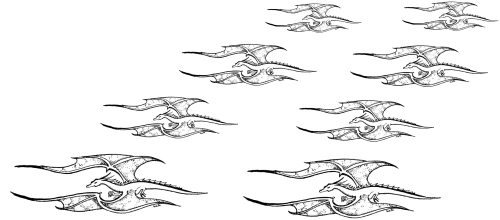
A Reserve unit practices formation flying over the Western border.
Since most military deaths occur in circumstances where it is impossible to return the body to the victim's family, it's customary for the surviving officers of a unit to eat any officers who have been killed; other ranks are eaten by their comrades and NCOs. For a regrettable minority, who could otherwise never afford dragon flesh, this is one of the incentives to serve.
One of the main weaknesses of Tiamath's current military organization is that it is ill-equipped to fight off a major invasion on the Northern plains. Recent scare stories of Migantil invasion and 'The Belshulath Peril' (such as the novel The Fall of Irieth) have highlighted this vulnerability, and Parliament is expected to budget for an expansion of heavy drafter-drawn artillery units and ground forces to cover this sensitive region. There is also concern that several Yarge nations are experimenting with powered lighter-than-air flight, which could counter Tiamath's main military advantage. A powered balloon carrying a few sharp-shooters or dropping explosive shells could be a lethal weapon in any future war. There are about six thousand serving soldiers, supplemented by a voluntary reserve with a thousand or so members, of who about a third have previous military experience. There appears to be enough equipment for the serving army, the readiness (or otherwise) of the reserve is less clear. Reservists must train for one week per year.
Soldiers use their rank as peer, if any, before their military title, e.g. "Dignified Captain Thonakie." Military ranks may be used as a courtesy title after a soldier retires. Military service can occasionally be a route to the peerage, but only if an Illustrious happens to be in a mood to grant a title for heroism.
There are no 'fashionable' companies, as such, but units based near Irieth are often assigned to duties such as guarding the Cupola, and are much more in the public eye than those on border duty.
| Contents |
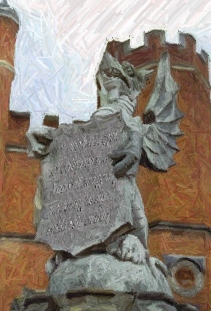 Camran bearing the Tablets of Law; statue outside the gates of the Courts of Justice, Irieth Clerical Ranks
Naturally there are many subtle gradations within each of these ranks; one Blessed may have a flock of a few dozen farmers, another a parish serving some of the wealthiest and most influential peers. Miracles and Magic |
Frelt looked from the angry parson to the angry Illustrious, and preened his wings a little. He was no Illustrious's parson, but the parson for the parish of Undertor, a large area that took in six demesnes, of which Agornin was one. This was part of what had given him his independence, and his inflated sense of his own rights. He had eaten his parson's share of eyes from all the dead and unfit for all of Undertor for fifty years, and he had done it without angering any of the Dignifieds under whom he served, save Bon Agornin alone, when he aspired to marry his daughter. Now his enemy lay dead, and he was appealed to by both parties.
Tooth and Claw - I:4
There are two main dragon religions, the Orthodox Faith and its precursor, which is known as the Old Religion; they differ in many respects, but to lay members the most obvious is that the Old Religion still allows confession. Until comparatively recently the Old Religion was considered a heresy and strongly suppressed; it is now permitted, although adherents are barred from government office and certain civil service posts, but even today the gap between the religions is wide enough to cause fights and riots. While the Orthodox Faith preaches its evolutionary message above all else, the Old Religion pays more attention to charity; an Orthodox parson confronted with a dying parishioner would wait for him to die then devour him, a cleric of the Old Religion would absolve him of his sins first.
Although Orthodox theologians tend to gloss over the details, their faith is based on the Old Religion, which began as a Yarge religion, adopted by dragons as a condition of their surrender after repeated Yarge victories. The harsher practices of the Orthodox Faith are a later invention, a justification for the population controls made essential by the limited territory of Tiamath. While the Old Religion seems kinder, Orthodoxy is actually better for the long-term survival of the race.
Almost all dragons belong to one of these faiths: the sincerely religious (including nearly all followers of the Old Religion); those who attend church on Firstday because everyone else does, without thinking much about it; and a sizeable minority - possibly a majority - who hypocritically profess Orthodoxy to conform. Atheism and agnosticism are not respectable positions, and there are no other dragon faiths; all were obliterated by the Yarge.
Both versions of the faith follow the trinity of Veld, Jurale, and Camran, and preach a doctrine of reincarnation based on spiritual merit; good dragons reincarnate as dragons, evildoers may come back as a muttonwool, a worm, or even a hideous Yarge! Other than that, they teach that Veld is the Creator of all things; he made the world, his blessing is increase, in vengeance he is sometimes shown as the Sun. Jurale added beauty and mercy. Finally, Camran brought Law (which he wrested from the demon Azashan), peace, and humility.
Priests bind their wings as a sign of humility, except in the event of a life-threatening emergency, or an emergency affecting the life or spiritual well-being of a follower. For example, they can fly to the death-bed of a parishioner if it will otherwise be impossible to reach her in time, or to escape from an avalanche or a band of marauding Yarge. Followers of both religions are expected to stay on the ground on the Sabbath (Firstday), but are not required to bind their wings.
A major difference between the Old Religion and the Orthodox Faith lies in their depiction of Camran as he walks towards Azashan's cave: Orthodox icons depict him as a dragon, the Old Religion shows him as a Yarge. But some Orthodox texts also depict Camran as a Yarge, allegedly to emphasise his peaceful nature and humility. The real truth, acknowledged by the Old Religion, is that the Yarge converted the dragons to their faith; all three members of the trinity were once shown as Yarge, and Azashan was originally shown as a dragoness. Scholars suspect that Azashan was once the Mother Goddess of the pre-Subjugation dragon religion!
It should not be assumed that the Old Religion is in any way disloyal to Dragonkind, or subservient to any Yarge faith. If anything the Old Religion regards itself as the last bastion of the true faith, which has long been forgotten by the heathen Yarge. Three thousand years is a long time in Yarge terms, more than a hundred generations, and in that time the Yarge version of the Old Religion has split repeatedly, and its offshoots have gone through many changes. The Trinity remain, but their roles and natures now bear little resemblance to the originals. The Draconic version has made a few changes of its own, of course. For example, Veld was a much less important figure in the original Yarge faith.
One of the few areas of agreement between the draconic churches is the need to bring the Yarge back to the Light of Veld. They jointly fund missionary work in the neighbouring Yarge kingdoms, so far with poor results. It is telling that the only major success has been in the Yegith Archipelago, a group of tiny islands sometimes known to Yarge as the "Cannibal Isles", and that there are reports that the islanders now worship dragons in general, not the Trinity in particular.
For some reason the Yarge generally seem to be very sceptical of the tenets of both Draconic faiths, especially those parts which recommend culling the young or disposing of the elderly before they become a burden on their relatives; so much so that missionaries are cautioned against making any reference to these articles of faith if an elderly Yarge or child is present. Neither church particularly needs more martyrs!
From time to time one Yarge faith or another sends missionaries to Tiamath; invariably they meet with no success.
| Contents |
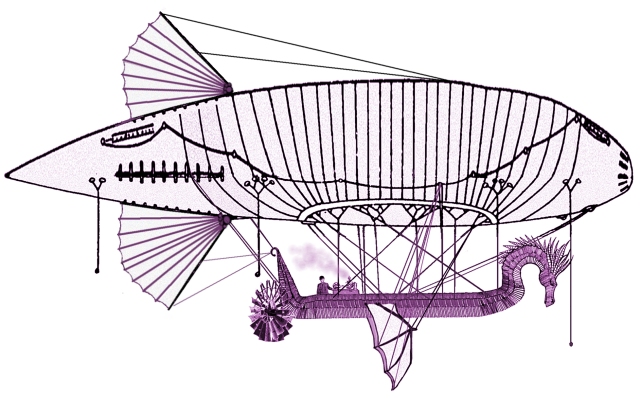 Artist's impression of a Yarge airship sighted over the Narrow Sea. It is believed to be a Migantil device. The basket, shaped in imitation of a dragon, was probably made of wicker. |
|
The Yarge Species Yarge are quadruped mammals (warm blooded hairy live-bearing animals) which have adapted to a vertical posture in which the rear limbs are used as legs and the upper limbs only for manipulation, as "arms" and "hands." The young are dependent on their mothers for the first two years of life, and often cannot fend for themselves until the age of ten or so. Despite their peculiar "bipedal" posture they are surprisingly agile, generally more so than a dragon of comparable size, and their manipulative limbs are always ready for use. Yarge have soft skin, without scales and considerably thinner than the underlying skin of dragons. Effectively their bodies have no natural defences, and are easily cut and otherwise damaged. To compensate most Yarge cover the entire body (not just the head) with garments made of wool and leather. Sometimes other materials such as silk and cotton are used. These garments provide some protection against abrasions etc. Nevertheless Yarge are unable to sit or lie comfortably for extended periods on rock, stone, or even gold, and must resort to "chairs" and "beds," raised padded nesting platforms with coverings again made of cloth. Yarge have no natural weapons; their claws are small and ineffectual, and they have no tail or fire, and small inefficient teeth. They compensate by using artificial weapons; clubs, swords and spears, and firearms. Most Yarge visitors to Tiamath are armed as allowed by treaty; outside Tiamath it can be assumed that most male Yarge expecting to encounter a dragon will be armed, as are females if they suspect any threat to their offspring. Despite their vulnerability the species is surprisingly adaptable, and has spread throughout the known world. Yarge typically live 60-100 years, with about one in ten surviving past the century; maximum life span is about 140 years, but this is extremely rare. From A Dragonet's Guide to Nature by The Blessed Jamanah Know Your Enemy!
Our Friends the Yarge
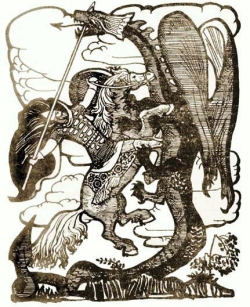 A Yarge warrior of the Subjugation, riding a "mount," distracts a dragon with his lance while his allies load their muskets and prepare to fire. The Yarge and Dragons Dragon Slayers |
He was utterly abhorrent to her. He stood scarcely six feet high and had no length at all, barely a foot, he was essentially flat. He wore a decent fleece hat, as anyone might, and he had covered most of his body likewise with cloth and jewels. He had hands like a maiden, but his skin was soft and smooth, entirely without scales. He looked weak and unarmored and defenseless, yet beside him the strongest dragon was as weak as a maiden. At his side hung the tube of a gun, with the like of which his kind had once overpowered dragonkind.
He bowed, almost folding himself in half and the exalt shuddered again.
"I am M'haarg, the Jh'oarg Ambassador," he said, as he straightened.
The vile creature could hardly pronounce the name of his own species, the Exalt noted.
Tooth and Claw - XVI:62
No dragon can look at a Yarge without a frisson of horror. They are the ancient Enemy, the Conquerors, the soft slug-like things that somehow overcame the dragons and destroyed the world as they knew it. Although they are individually weak, they have the strength of numbers and a huge advantage in land, weapons, and technology. Any dragon, even an elderly matron as described above, can kill an individual Yarge with one bite or blow, if the Yarge fails to fire first; the problem is the aftermath. Once aroused the species shows no restraint, avenging the death of even one of their kind by all possible means, even if it ultimately leads to the death of dozens or hundreds of Yarge.
Dragon philosophers suspect that the cause of this extraordinary behaviour is their short lifespan; few Yarge live even a hundred years, and most are past their prime at sixty. An obvious consequence of this short lifespan is that Yarge breed fast; they bear their young live, and females can give birth when they are less than twenty years old. While individual litters are small, typically one and more rarely two or three offspring, the females seem to be able to reproduce at intervals of about two years until they are approximately forty to fifty years old. While a small portion of these offspring die in infancy, most survive to adulthood. There appears to be no attempt to cull them as a matter of course. As a result a single Yarge female may have several hundred descendents after two hundred years; by comparison, a dragon family will barely be in the second or third generation, with no more than fifteen or twenty offspring. No matter how many Yarge may be killed, there will always be more; dreams of a final cataclysmic end to the Yarge problem, as seen in the scientific romances of Segievel Yepragis, are wishful thinking. Most dragons are aware of these facts but reluctant to face them.
Science: Most of Tiamath's technological innovation derives from Yarge ideas; Yarge have more need for the fruits of science, since their physical capacities are so limited, and devote great ingenuity to devising vehicles of all sorts, devices to amplify their pitiful muscles, tools to perform jobs tasks that a dragon can manage with his claws, etc. Their short lives seem to incline them to take foolish chances - a dragon confronted with a thunderstorm will land, take cover, and wait it out, a Yarge might well decide to fly a kite up into the clouds to see how the lightning works! Often Yarge seem to adopt new devices before they are properly tested; it took less than a hundred years for the railway network to cover most of the rest of the continent, the dragons of Tiamath took nearly two hundred years to decide to build their own, another century to settle on details such as track width. Having said that, many Yarge devices do not stand the test of time, while anything built by dragons is probably going to be used for hundreds of years.
The most typical Yarge technology is the steam engine, in all its many guises, some of which have been adapted to the needs of dragons. An important difference between Dragon and Yarge use of steam is that Dragon engines use sensibly low pressure, typically 25 to 50 PSI; Yarge machinery usually operates at dangerously high pressure, 100 to 150 PSI, sometimes more. High pressure operation is more efficient, of course, but the danger of boiler explosions etc. is considerable, and dragons prefer to avoid it.
Trains are common throughout the Yarge world; they run their lines much faster than dragons, with speeds sometimes exceeding 50 MPH (to avoid confusion speeds are in Terran MPH or knots, not the equivalent Draconic or Yarge units), and these excessive speeds plus the narrower tracks result in frequent accidents. Passenger wagons are closed, not open, so that victims cannot even fly clear!
On the roads steam carriages and wagons have been developed in most nations. Carriages can carry four or six Yarge at 20-30 MPH; wagons carry five or ten tons of cargo at 10-20 MPH, with faster versions of both under development. The armies of Belshulath and the Edawoon Republic are experimenting with armoured wagons capable of carrying a troop of soldiers and pulling a field gun; fortunately they seem to have trouble on a gradient, and would probably be less than useful on the mountain roads which are typical of Tiamath.
All of the Yarge seafaring nations have steamships (including warships) built for coastal seas, and capable of speeds up to ten or fifteen knots. Most are paddle steamers, though screw propellers are becoming more common. There are a few ocean-going ships with steam engines, but they can't carry enough wood or coal to make a complete voyage to any of the other continents under power; instead they proceed under sail unless becalmed or forced to manoeuvre against the weather. Few sailors, even Yarge, will tackle an oceanic voyage with equanimity; the risks are too great.
On inland waters steam launches and powered barges are very common, largely replacing the drafter-hauled barges of previous centuries and more recent paddle steamers. Most now have screw propellers, and a top speed around 10 MPH.
There have been several attempts to build submarines, but their usefulness is limited; the boilers must be extinguished as the vessel submerges, it isn't possible to travel more than a mile or two on stored steam pressure, and the hull starts to buckle and leak at depths of thirty to forty feet.
Finally, the cutting edge of transport technology is in the air, with powered balloons (sometimes known as "airships") capable of carrying several men and their weapons under development in every nation. At the moment none of these devices seem to work particularly well, so far as Tiamath is aware, and all of them seem to have vulnerabilities to weather and fire that probably rule them out as serious military devices, but that may change as the technology is improved.
Yarge scientists are looking for smaller and lighter engine designs, and alternatives to steam as a power source; the problem isn't so much the engine or the fuel as the pure water an engine needs. All engines leak steam, and while it might in theory be possible to come up with a completely self-contained design which cools the steam back to water and re-uses it, so far this has not been accomplished. Lighter engines would allow faster steam carriages and wagons, and would make an enormous difference to the performance of airships. Even ships must take on fresh water occasionally, or devote valuable fuel to removing salt and other impurities from sea water before it is used. Just the ability to avoid stopping to take on water would make a significant difference to travel times, which are of course very important to the short-lived Yarge.
Steam is also widely used in factories, mines, and mills and elsewhere in industry, supplementing or replacing earlier forms of power such as windmills, water-wheels, etc.
Other areas of technology are also more advanced in the Yarge countries than in Tiamath. Yarge advances in optics were briefly mentioned in an earlier section; these include the magnifying glass and microscope, telescope, and binoculars; the latter being essentially two telescopes side by side, which are apparently more comfortable for Yarge eyes. None of these devices can be used by dragons, due to the differences in their eyes, but with the exception of the microscope they are hardly missed, and another Yarge invention - the microscope projector - is an acceptable if somewhat more cumbersome substitute.
A recent invention of greater interest is the "camera": a box with a lens at one end, containing a glass plate coated with a layer of chemicals which are sensitive to light. If light falls onto the plate for approximately twenty seconds to a minute, and it is then treated with various chemicals, a "negative image" of the brighter parts of the scene forms on the surface, while the darker parts become transparent. With a matt black background behind the glass plate the negative image reflects light, the clear parts absorb it, so that dark and light are as the original scene! It's also possible to put the plate in front of a bright light and trace the image onto paper, then (via a complex and laborious process) etch the resulting picture onto a printing plate, so that copies can be mass-produced in books and popular journals. By this means the camera has begun to supplant the work of the artist in some respects, although it is to be hoped that it will never do so entirely. There are obvious limitations, such as an inability to show colour. The process isn't widely used in Tiamath as yet, although some recent illustrations in the Irieth Journal have been made by this method. The Orthodox Faith is currently debating the propriety of using this method to create portraits of leading citizens, as suggested in the Journal. The high light levels needed would make some forms of portraiture impossible - it seems unlikely that any dragon could be depicted in his home, for example - so the whole procedure does seem somewhat foreign to draconic taste, but the Faith will decide.
Yarge medicine has made great strides in the past century. The "germ theory" of disease has been essentially proven, and the technique of inoculation now prevents some of the more common illnesses. Boiled bandages and cleanliness during surgery make an enormous difference to survival after injuries of all sorts. This progress suggests that the "great plague" resulting from Yarge overpopulation, keenly anticipated by some dragon optimists, will not now take place. There is instead a fear that the Yarge will turn their knowledge of disease to destructive purposes, developing a plague to devastate Tiamath. There is even a theory that the outbreak of Virulent Scale Rot of '87 was an experiment in this direction. While it only killed those who were already infirm, mostly dragonets and the elderly, it could have been a trial run for something much more devastating.
Yarge experiments with the electric fluid are somewhat more advanced than those conducted in Tiamath, and the Migantil Railway Company is in the process of setting up a system of wires to allow the movement of trains to be coordinated by electrical signals, transmitted as a pattern of long and short pulses resembling the codes used for heliograph messages. Similar experiments have been begun in Tiamath. If the system works, and improves safety, it is likely to be adopted reasonably quickly by Tiamath's railways, but first its impact on other matters, such as the activities of the post office, must be assessed. Nevertheless, it seems likely to enter service within ten to fifteen years.
Arts: While it's easy to think of the Yarge only in terms of their numbers and science and the threat that they might pose to dragonkind, it should be remembered that the Yarge too have their great artists, philosophers, and poets. They may not always be appreciated by dragons, but they do exist, and must have some indirect effect on dragon thought and society. Numerous Yarge books have achieved some popularity (or notoriety) in Tiamath; for example, the draconic translation of The Biology of Dragons by Lh'ook of Migantil has been in print continuously for nearly three centuries, and sets the standard by which Draconic scientific textbooks are judged. Many Yarge plays and novels have been adapted for a draconic audience, although sometimes much changed in the translation. It may be hard to believe, but the comedy Ten Pounds of Flesh, with its corrupt lawyers defrauding the lovable moneylender and receiving their come-uppance in court, when their client's heart is ripped out and their fees remain unpaid, was originally conceived as a tragedy in which the moneylender is ultimately robbed of his rightful dues.
Yarge society looks like and is very odd to dragons; they will always be odd outsiders from the dragon viewpoint, and vice versa. They have odd and barely-pronounceable names, eat weird cooked food, have no patience, and look disgusting. But beyond all that, all of the Yarge cultures have been influenced by thousands of years of war with dragonkind, a legacy that isn't easily forgotten. While they may sometimes seem to have lost their edge, and even talk as though they are prepared to let bygones be bygones, there's still steel lurking under the surface. There are martial arts traditions everywhere, and there's a good chance that at least one member of any group of Yarge encountered will be armed and moderately dangerous. All Yarge dwellings within fifty or soo miles of the border with Tiamath are defensible. One of the reasons for the relatively slow pace of technological development is that until recently Yarge culture simply hasn't considered it nearly as important as military preparedness - but this is changing as the military usefulness of technology becomes apparent.
Yarge live and party hard, their soldiers despise any display of fear, and their languages are only marginally similar to Draconic, despite frequent "borrowings" between the languages. The range of their speech is different; dragons have a lower register, and often perceive Yarge voices as high-pitched and unpleasant.
While dragons consider their hats the only costume that can possible be needed, Yarge cover their entire bodies. Clothing emphasises elaborate brocades, gold and silver threads, heavily layered cloth that can easily conceal weapons and provides protection against long cold nights. Both sexes use cosmetics including eye liner, blusher, appliquéd beauty spots, and perfume. They don't easily welcome dragons into their lives - tourists are tolerated for their gold and bilked of as much of it as possible, not liked - and will easily misinterpret dragon actions as hostile, even if they are trying to be helpful. A very few dragons are treated with real respect; typically after they have done something genuinely dangerous that helped Yarge, such as rescuing someone from a flood or a burning building, and only if there is no way that their actions can be interpreted as having endangered Yarge.
Conclusions: While much about Yarge behaviour is baffling to dragons, or seems disgustingly unpleasant, it cannot be denied that the economy of modern Tiamath is to a large extent driven by interactions with neighbouring Yarge nations; without it the financial sector would be in disarray, and the manufacturing industries would be considerably less profitable. There are drawbacks to this association, of course - most dragons with an interest in finance are aware of the disastrous panic of '98, initially caused by a run on the Belshulath florin - but on the whole the relationship benefits Tiamath, and must be encouraged while there is peace between Dragon and Yarge.
| Game note: While none of the historical nations of our world come particularly close to the Yarge, the nations bordering Tiamath are in some respects a little like pre-revolutionary Russians, with a touch of Greek, Cossack, Mongol, and Oriental influences. Try to mix customs from multiple cultures and keep the dragons guessing!
Some details of the relationship between the Yarge and Tiamath have been omitted from this section since they would be unknown to most dragons - see the Epilogue for more. |
| Contents |
Q. What else would you suggest people read, I mean, if they were to enjoy Tooth and Claw?
A. Anthony Trollope. Good places to start are the stand-alone books, like The American Senator, The Vicar of Bullhampton, Is He Popenjoy?, Orley Farm. Trollope wrote about forty novels and I haven't found them all yet. The series are splendid, but they have to be read in order and it isn't always easy to find them in order. There's a great Trollope resource page. Other than Trollope, a few really good modern Victorian novels are John Fowles's The French Lieutenant's Woman, Margaret Forster's Lady's Maid, A.S. Byatt's Possession.
Jo Walton - Tooth and Claw FAQ
"She'd like me to bring a dragon home, I suppose. It would serve her right if I did, some creature that would make the house intolerable to her."
Anthony Trollope - Framley Parsonage, 1859, quoted in Tooth and Claw.
Referees who wish to reflect the Tooth and Claw setting accurately should begin by reading the book itself; the excerpts in this game can't give more than a hint of the flavour of the novel. At the time of writing (May 2008) it's out of print, but copies are readily available through numerous dealers. The unfinished sequel Those Who Favor Fire accompanies this sourcebook, but read Tooth and Claw first! Tooth and Claw bases much of its plot on social customs, etiquette, and the behaviour of its characters, with events driven by personalities. There is no "fiendish plot" driving events, just a series of circumstances that eventually culminate in a court case and the death of one of the characters, several romances, and the disgrace of someone with ideas above his station in life. It's entirely possible to follow this example and run a game that's based entirely on social interaction, with no violence other than that inherent in the normal personalities of dragons. For this sort of campaign the best source is probably Trollope. Numerous titles can be found on line via Project Gutenberg and other copyright-expired sources; see e.g. http://digital.library.upenn.edu/books/index.html and search for Trollope under author's names.
Several other authors were writing similar novels of society around the same period; see in particular the works of Jane Austen, Henry James and (a little later) John Galsworthy, also easily found on line.
If players prefer a more active type of campaign your best source is probably Victorian detective and adventure stories; the works of Wilkie Collins, most notably The Moonstone (1868) and The Woman in White (1860), are particularly good examples of the genre. In a more comedic vein The Wrong Box by Robert Louis Stevenson and Lloyd Osbourne (1889) offers a light-hearted tale of concealed death, inheritance, and deception with a very draconic feel; the 1966 film starring Michael Caine, Peter Cook, and Dudley Moore is also recommended, though it lacks some of the demented logic of the novel. The Wikipedia article on Tontines, the odd form of lottery which drives the plot of The Wrong Box, may also be a useful source of plot ideas.
Another excellent film, though set in the Edwardian era, is Kind Hearts and Coronets (1949), starring Dennis Price and Alec Guinness, in which a distant relative of a duke decided to take the title by the simple method of killing everyone who stands in his path. A verse in the section on character traits derives from this film.
Adventures in Yarge territory could be based on plots in which relative innocents run into trouble abroad (see Henry James, in particular The Portrait of a Lady (1881), The Ambassadors (1903), and The Golden Bowl (1904)), in which adventurers seek strange animals or unknown civilizations (see e.g. most of Verne's work), or any type of period military adventure. Although slightly anachronistic, novels of the Napoleonic wars or Britain's colonial wars in India may be appropriate for a dragon military campaign; see most of Patrick O'Brian's nautical novels for characters with the right period feel, Kipling's Indian Army stories, or George MacDonald Fraser's Flashman novels for a more cynical approach to military life.
Finally, GURPS Dragons (2004) by Phil Masters is probably the best role-playing reference for dragons in a variety of settings, and is strongly recommended.
| Contents |
Click on any of the images below to open large graphics files of dragons or Yarge.
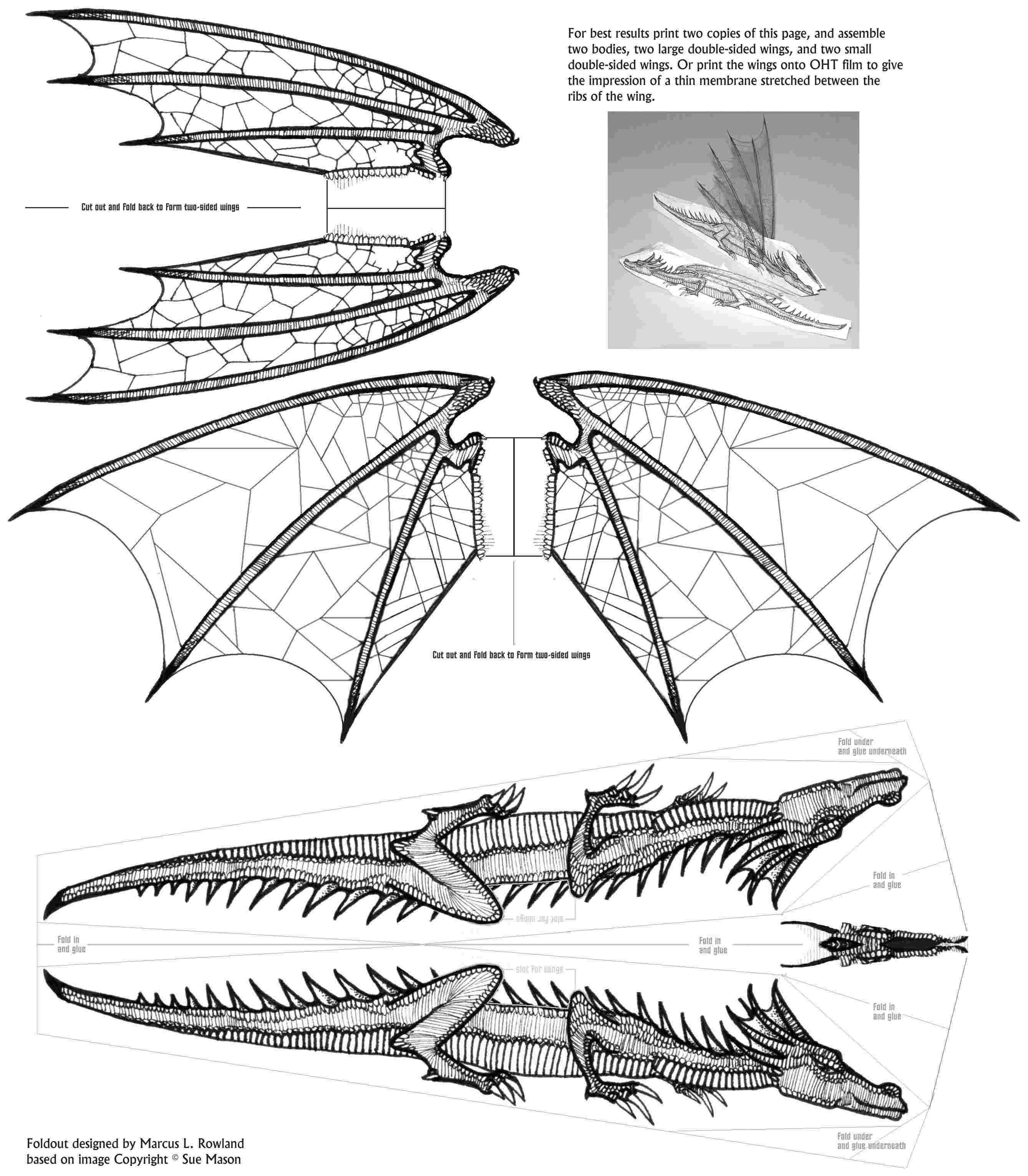 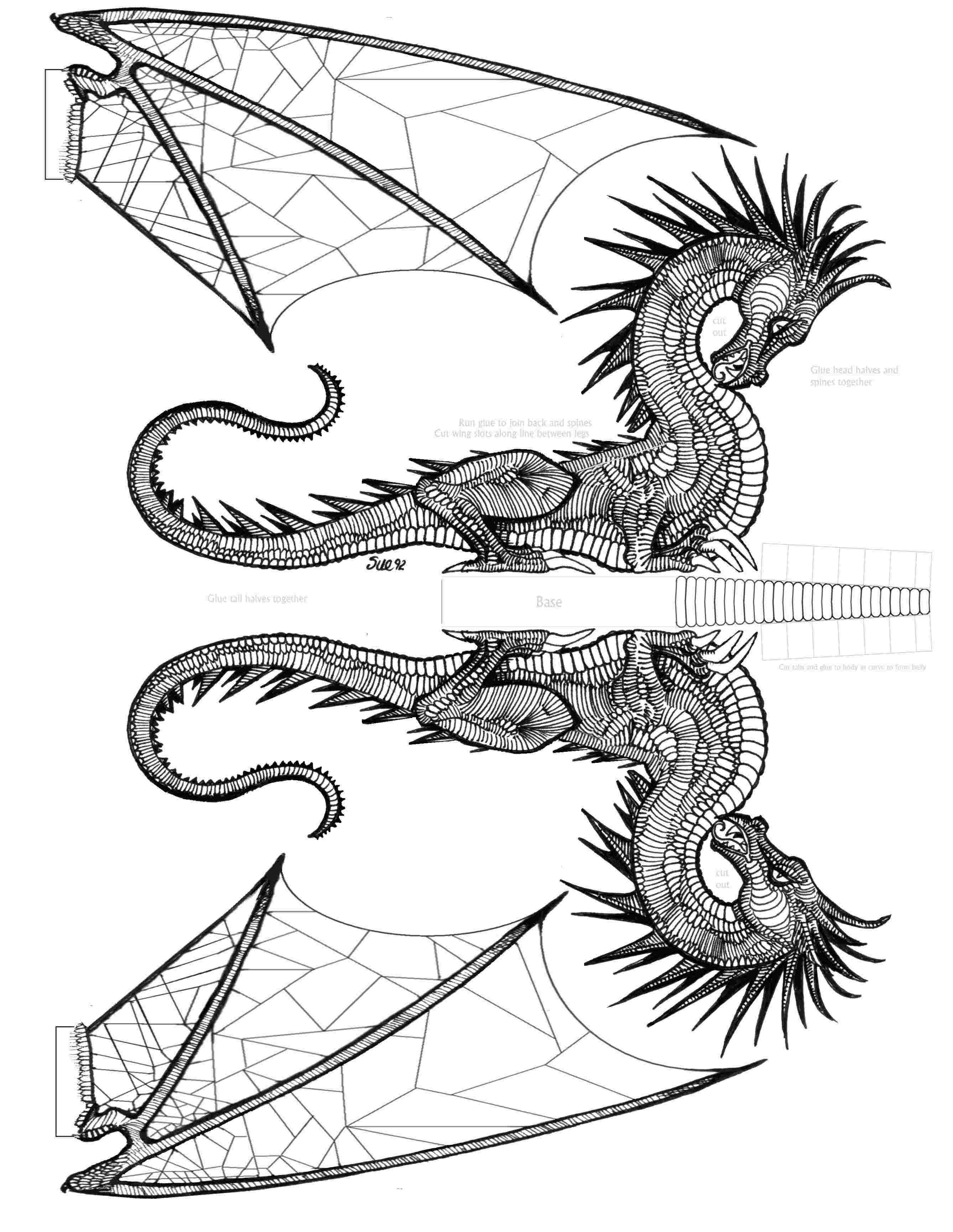 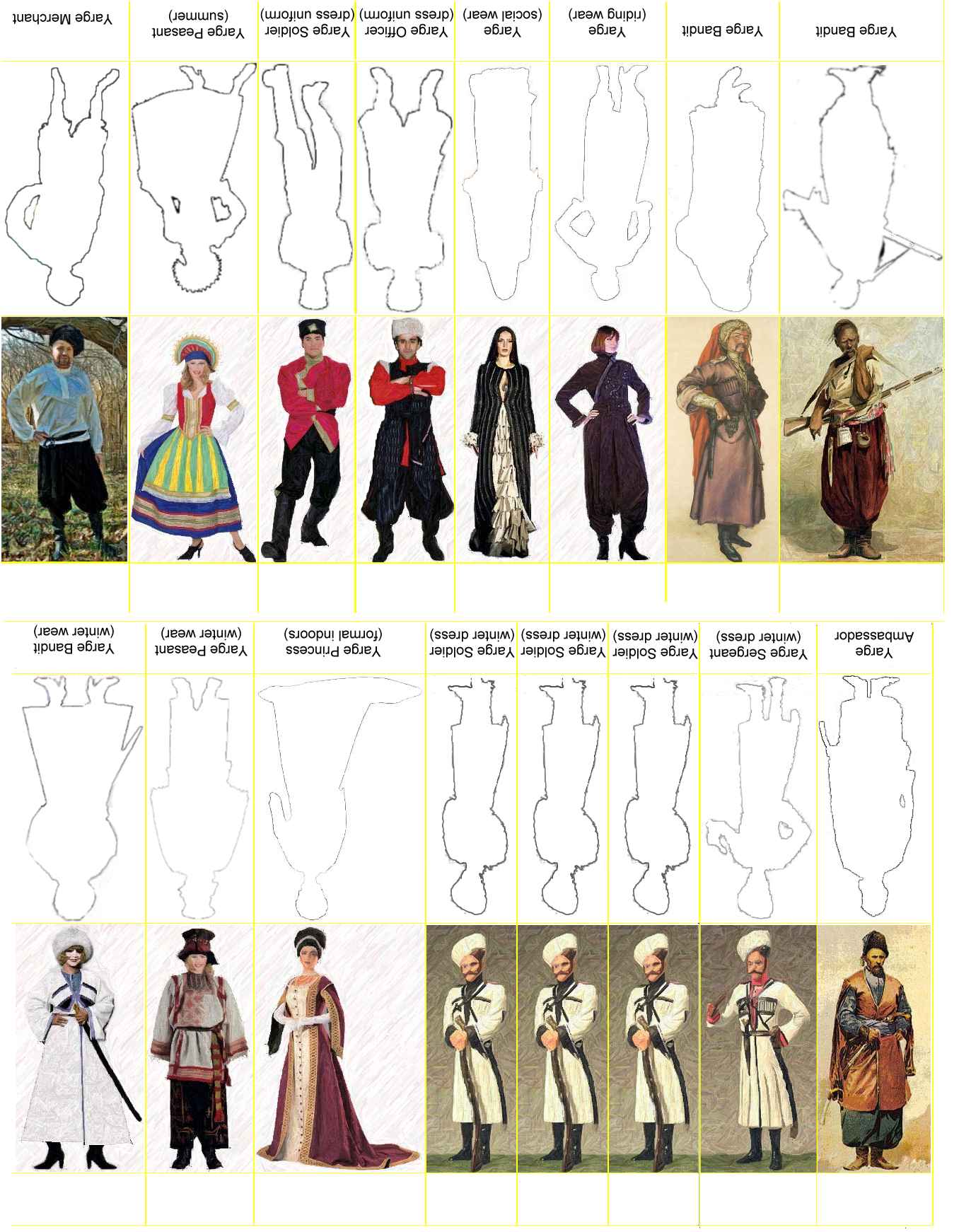  |
To make two smaller dragons, one flying, one with folded wings: Print two copies of first sheet on thick paper or card. Cut out bodies and wing assemblies. Fold the wings double and glue them together so that they are double-sided. Cut slots following the grey line from the front knee joint back down to the spine, then along the spine to the rear leg, and round the rear knee to the end of the grey line. Fold the body along its axis, add the creases as shown and glue them together, then slot the wings into the body so that the back of the wings are behind the rear knees. Optionally put modelling clay inside the body to improve stability and paint gold, pink, or red for females, blue, grey, or dark brown for males. These figures represent large dragons and are oversized compared to the Yarge.
~ Index ~ Rules ~ Adventures ~
~ Single-File Version ~ Contents ~